Management Accounting Report: Systems and Financial Analysis
VerifiedAdded on 2023/01/18
|23
|5234
|31
Report
AI Summary
This report offers a thorough exploration of management accounting, commencing with an introduction to its core principles and objectives. The main body of the report delves into the definition of management accounting, its role within business entities, and its key principles. A case study of Continental Clothing Limited is used to illustrate practical applications. The report examines various management accounting systems, including cost accounting, inventory management, job costing, and price optimization systems, outlining their benefits and applications. It also covers financial statement preparation, emphasizing the importance of reliable, up-to-date, and understandable information. The report concludes by discussing different types of managerial accounting reports, such as budget reports, performance reports, and inventory valuation reports, providing a comprehensive overview of management accounting practices and their significance in business decision-making. The report also covers micro economics techniques, cost analysis, break even analysis, and discusses the importance of relevant, up-to-date, and accurate financial information.
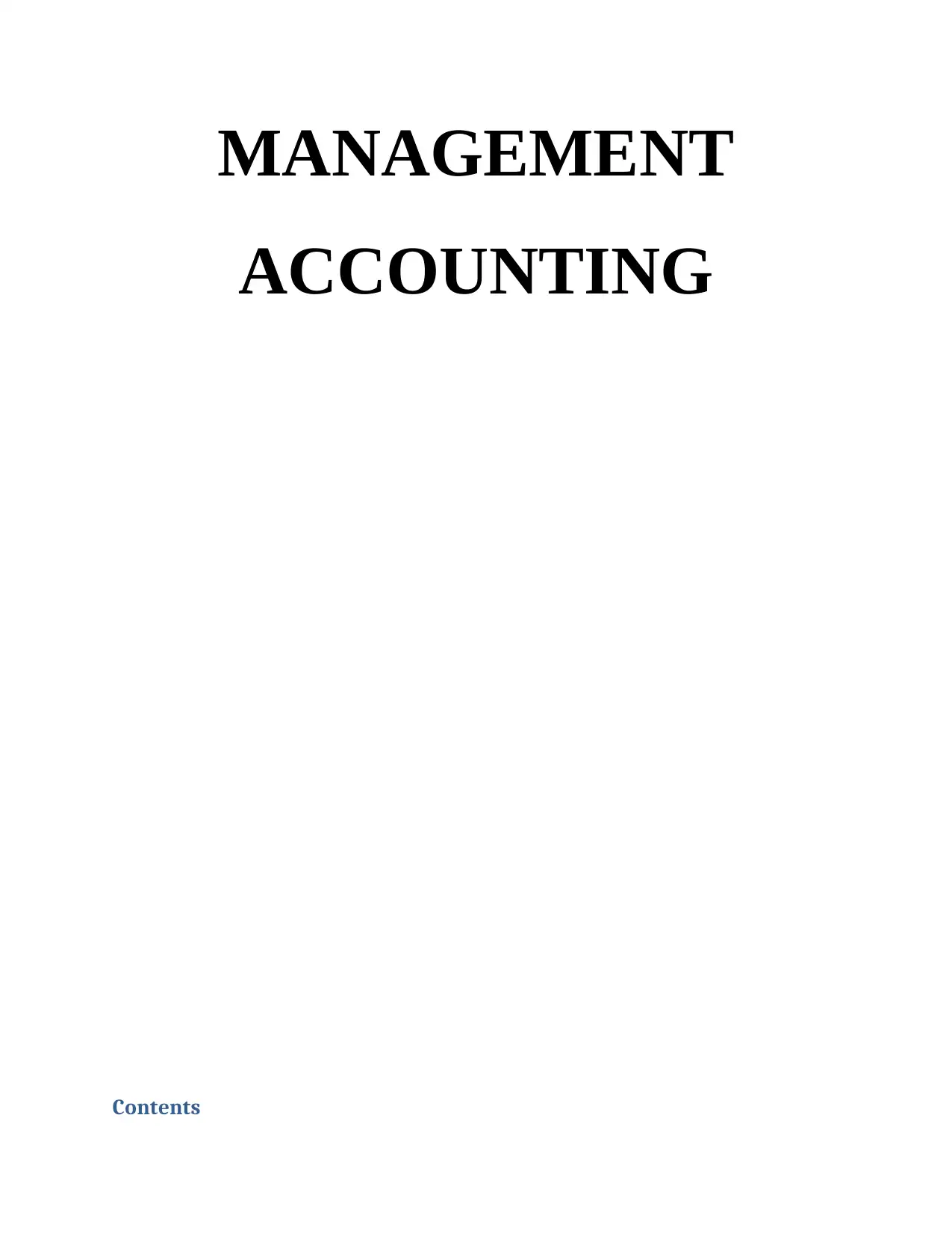
MANAGEMENT
ACCOUNTING
Contents
ACCOUNTING
Contents
Secure Best Marks with AI Grader
Need help grading? Try our AI Grader for instant feedback on your assignments.
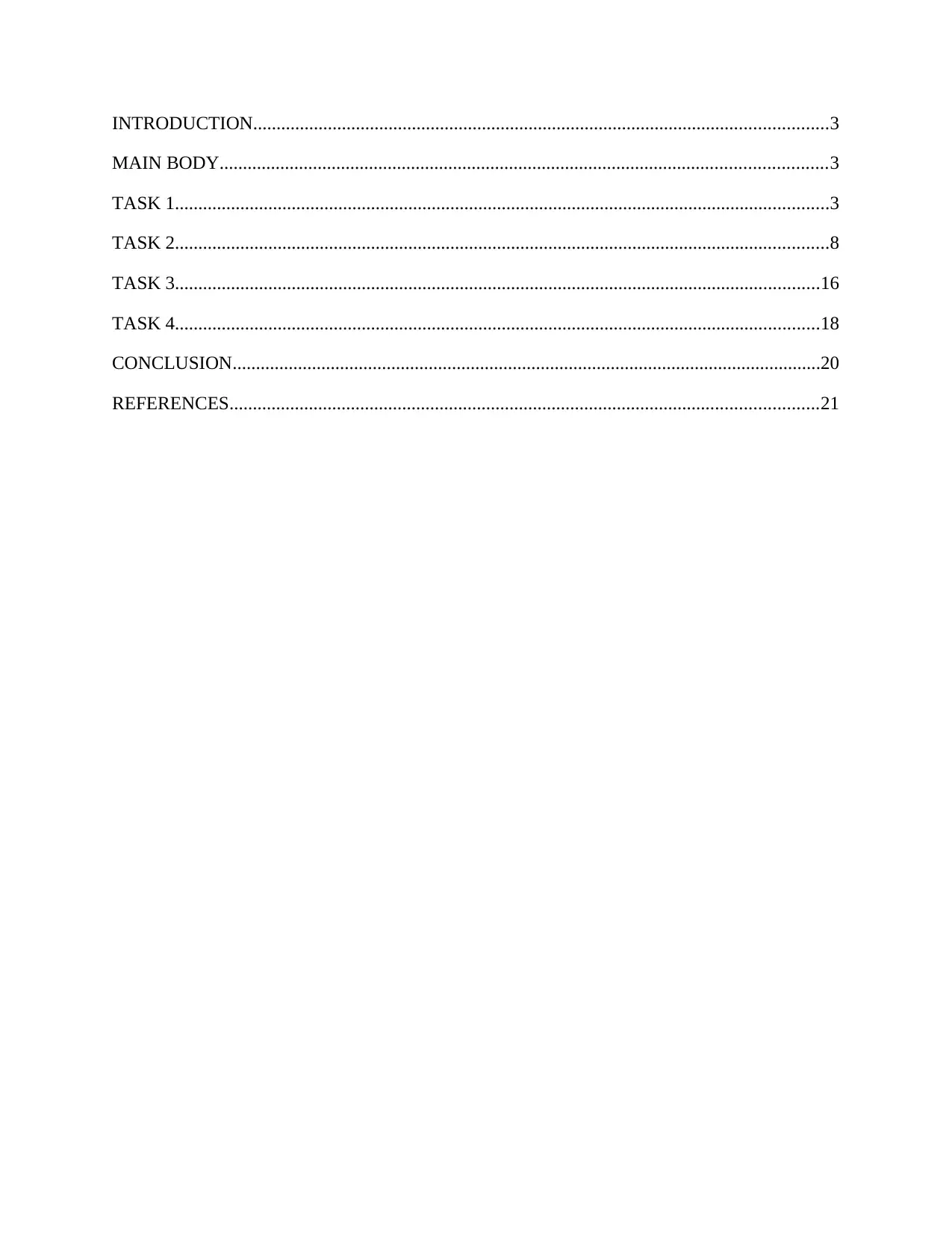
INTRODUCTION...........................................................................................................................3
MAIN BODY..................................................................................................................................3
TASK 1............................................................................................................................................3
TASK 2............................................................................................................................................8
TASK 3..........................................................................................................................................16
TASK 4..........................................................................................................................................18
CONCLUSION..............................................................................................................................20
REFERENCES..............................................................................................................................21
MAIN BODY..................................................................................................................................3
TASK 1............................................................................................................................................3
TASK 2............................................................................................................................................8
TASK 3..........................................................................................................................................16
TASK 4..........................................................................................................................................18
CONCLUSION..............................................................................................................................20
REFERENCES..............................................................................................................................21

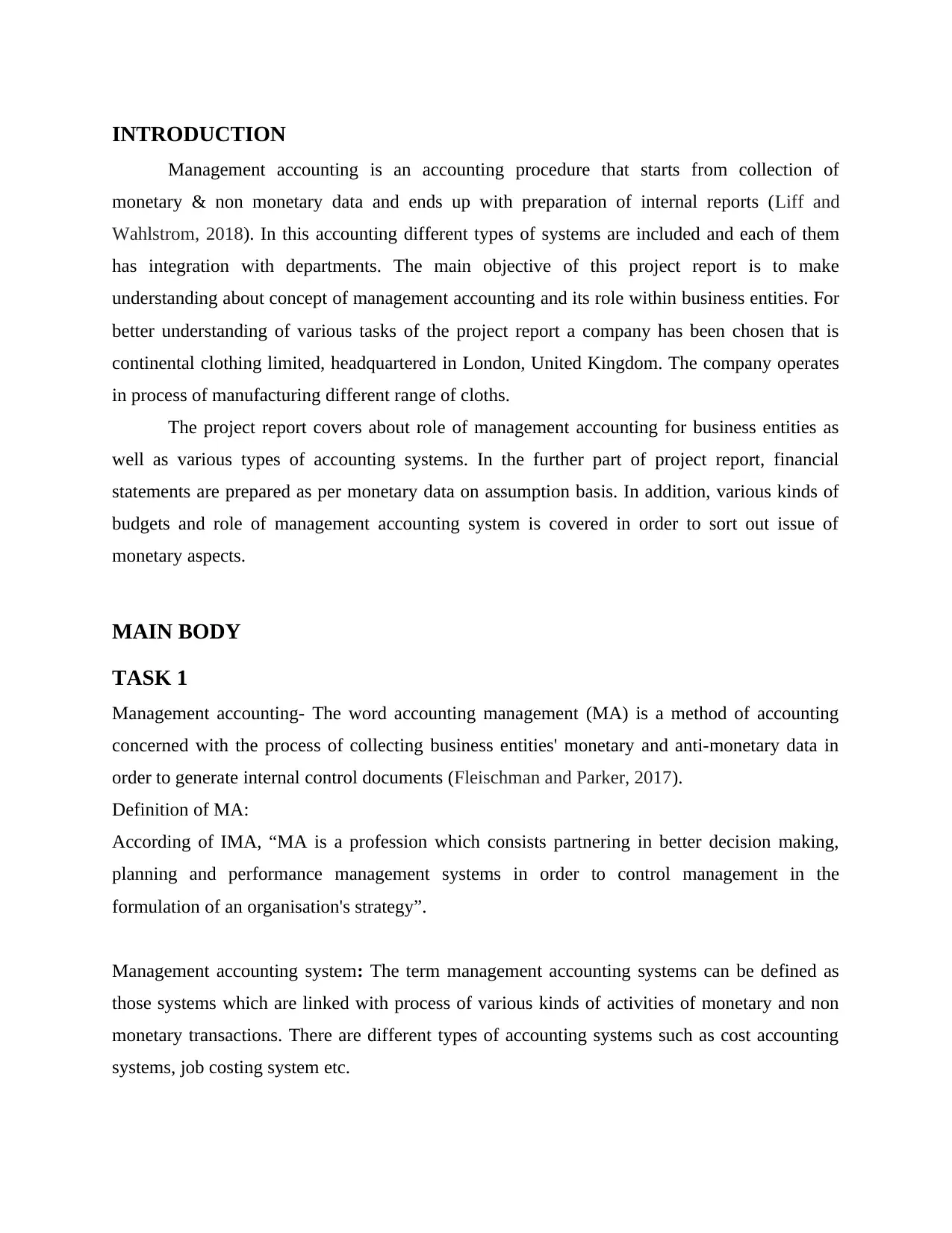
INTRODUCTION
Management accounting is an accounting procedure that starts from collection of
monetary & non monetary data and ends up with preparation of internal reports (Liff and
Wahlstrom, 2018). In this accounting different types of systems are included and each of them
has integration with departments. The main objective of this project report is to make
understanding about concept of management accounting and its role within business entities. For
better understanding of various tasks of the project report a company has been chosen that is
continental clothing limited, headquartered in London, United Kingdom. The company operates
in process of manufacturing different range of cloths.
The project report covers about role of management accounting for business entities as
well as various types of accounting systems. In the further part of project report, financial
statements are prepared as per monetary data on assumption basis. In addition, various kinds of
budgets and role of management accounting system is covered in order to sort out issue of
monetary aspects.
MAIN BODY
TASK 1
Management accounting- The word accounting management (MA) is a method of accounting
concerned with the process of collecting business entities' monetary and anti-monetary data in
order to generate internal control documents (Fleischman and Parker, 2017).
Definition of MA:
According of IMA, “MA is a profession which consists partnering in better decision making,
planning and performance management systems in order to control management in the
formulation of an organisation's strategy”.
Management accounting system: The term management accounting systems can be defined as
those systems which are linked with process of various kinds of activities of monetary and non
monetary transactions. There are different types of accounting systems such as cost accounting
systems, job costing system etc.
Management accounting is an accounting procedure that starts from collection of
monetary & non monetary data and ends up with preparation of internal reports (Liff and
Wahlstrom, 2018). In this accounting different types of systems are included and each of them
has integration with departments. The main objective of this project report is to make
understanding about concept of management accounting and its role within business entities. For
better understanding of various tasks of the project report a company has been chosen that is
continental clothing limited, headquartered in London, United Kingdom. The company operates
in process of manufacturing different range of cloths.
The project report covers about role of management accounting for business entities as
well as various types of accounting systems. In the further part of project report, financial
statements are prepared as per monetary data on assumption basis. In addition, various kinds of
budgets and role of management accounting system is covered in order to sort out issue of
monetary aspects.
MAIN BODY
TASK 1
Management accounting- The word accounting management (MA) is a method of accounting
concerned with the process of collecting business entities' monetary and anti-monetary data in
order to generate internal control documents (Fleischman and Parker, 2017).
Definition of MA:
According of IMA, “MA is a profession which consists partnering in better decision making,
planning and performance management systems in order to control management in the
formulation of an organisation's strategy”.
Management accounting system: The term management accounting systems can be defined as
those systems which are linked with process of various kinds of activities of monetary and non
monetary transactions. There are different types of accounting systems such as cost accounting
systems, job costing system etc.
Secure Best Marks with AI Grader
Need help grading? Try our AI Grader for instant feedback on your assignments.
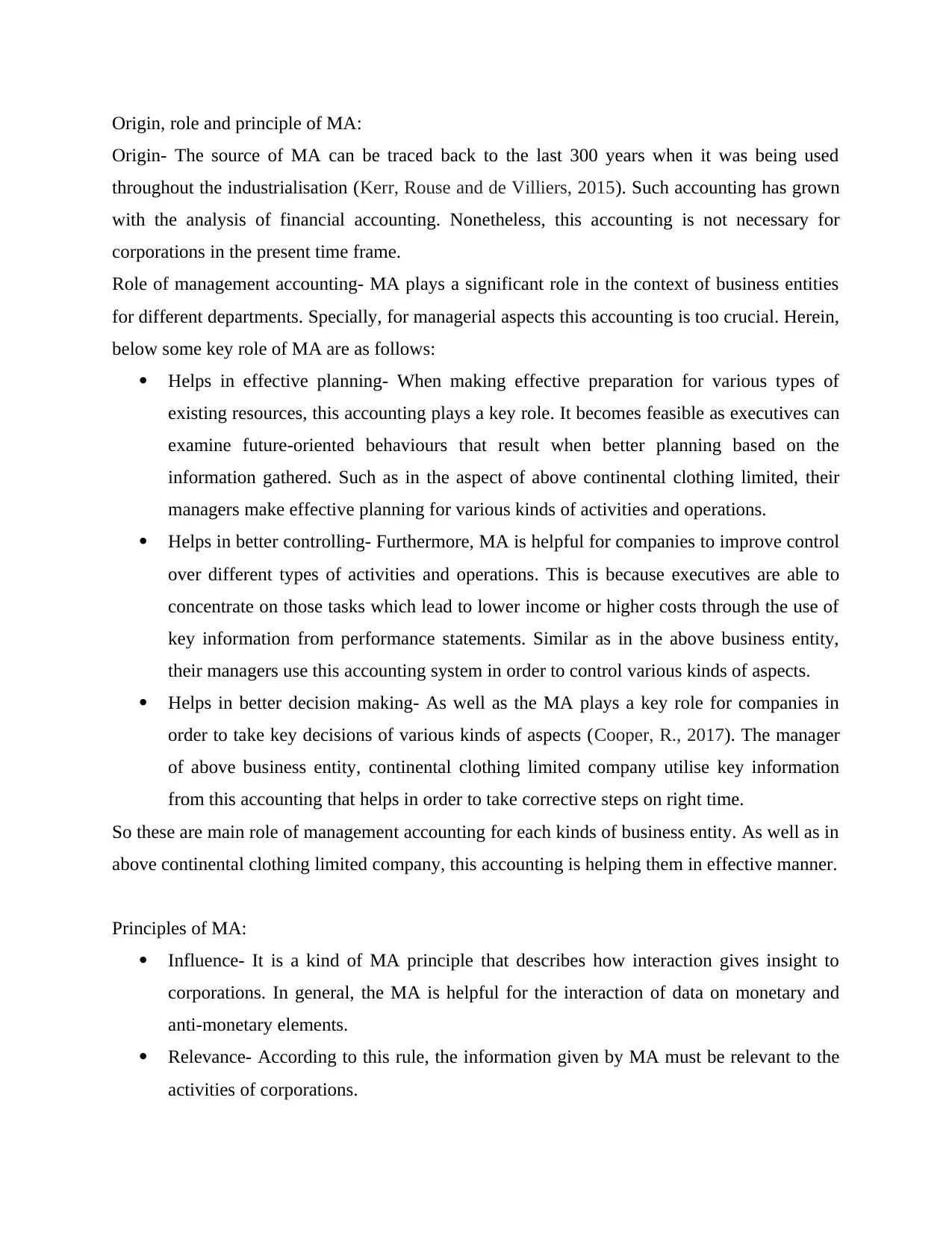
Origin, role and principle of MA:
Origin- The source of MA can be traced back to the last 300 years when it was being used
throughout the industrialisation (Kerr, Rouse and de Villiers, 2015). Such accounting has grown
with the analysis of financial accounting. Nonetheless, this accounting is not necessary for
corporations in the present time frame.
Role of management accounting- MA plays a significant role in the context of business entities
for different departments. Specially, for managerial aspects this accounting is too crucial. Herein,
below some key role of MA are as follows:
Helps in effective planning- When making effective preparation for various types of
existing resources, this accounting plays a key role. It becomes feasible as executives can
examine future-oriented behaviours that result when better planning based on the
information gathered. Such as in the aspect of above continental clothing limited, their
managers make effective planning for various kinds of activities and operations.
Helps in better controlling- Furthermore, MA is helpful for companies to improve control
over different types of activities and operations. This is because executives are able to
concentrate on those tasks which lead to lower income or higher costs through the use of
key information from performance statements. Similar as in the above business entity,
their managers use this accounting system in order to control various kinds of aspects.
Helps in better decision making- As well as the MA plays a key role for companies in
order to take key decisions of various kinds of aspects (Cooper, R., 2017). The manager
of above business entity, continental clothing limited company utilise key information
from this accounting that helps in order to take corrective steps on right time.
So these are main role of management accounting for each kinds of business entity. As well as in
above continental clothing limited company, this accounting is helping them in effective manner.
Principles of MA:
Influence- It is a kind of MA principle that describes how interaction gives insight to
corporations. In general, the MA is helpful for the interaction of data on monetary and
anti-monetary elements.
Relevance- According to this rule, the information given by MA must be relevant to the
activities of corporations.
Origin- The source of MA can be traced back to the last 300 years when it was being used
throughout the industrialisation (Kerr, Rouse and de Villiers, 2015). Such accounting has grown
with the analysis of financial accounting. Nonetheless, this accounting is not necessary for
corporations in the present time frame.
Role of management accounting- MA plays a significant role in the context of business entities
for different departments. Specially, for managerial aspects this accounting is too crucial. Herein,
below some key role of MA are as follows:
Helps in effective planning- When making effective preparation for various types of
existing resources, this accounting plays a key role. It becomes feasible as executives can
examine future-oriented behaviours that result when better planning based on the
information gathered. Such as in the aspect of above continental clothing limited, their
managers make effective planning for various kinds of activities and operations.
Helps in better controlling- Furthermore, MA is helpful for companies to improve control
over different types of activities and operations. This is because executives are able to
concentrate on those tasks which lead to lower income or higher costs through the use of
key information from performance statements. Similar as in the above business entity,
their managers use this accounting system in order to control various kinds of aspects.
Helps in better decision making- As well as the MA plays a key role for companies in
order to take key decisions of various kinds of aspects (Cooper, R., 2017). The manager
of above business entity, continental clothing limited company utilise key information
from this accounting that helps in order to take corrective steps on right time.
So these are main role of management accounting for each kinds of business entity. As well as in
above continental clothing limited company, this accounting is helping them in effective manner.
Principles of MA:
Influence- It is a kind of MA principle that describes how interaction gives insight to
corporations. In general, the MA is helpful for the interaction of data on monetary and
anti-monetary elements.
Relevance- According to this rule, the information given by MA must be relevant to the
activities of corporations.
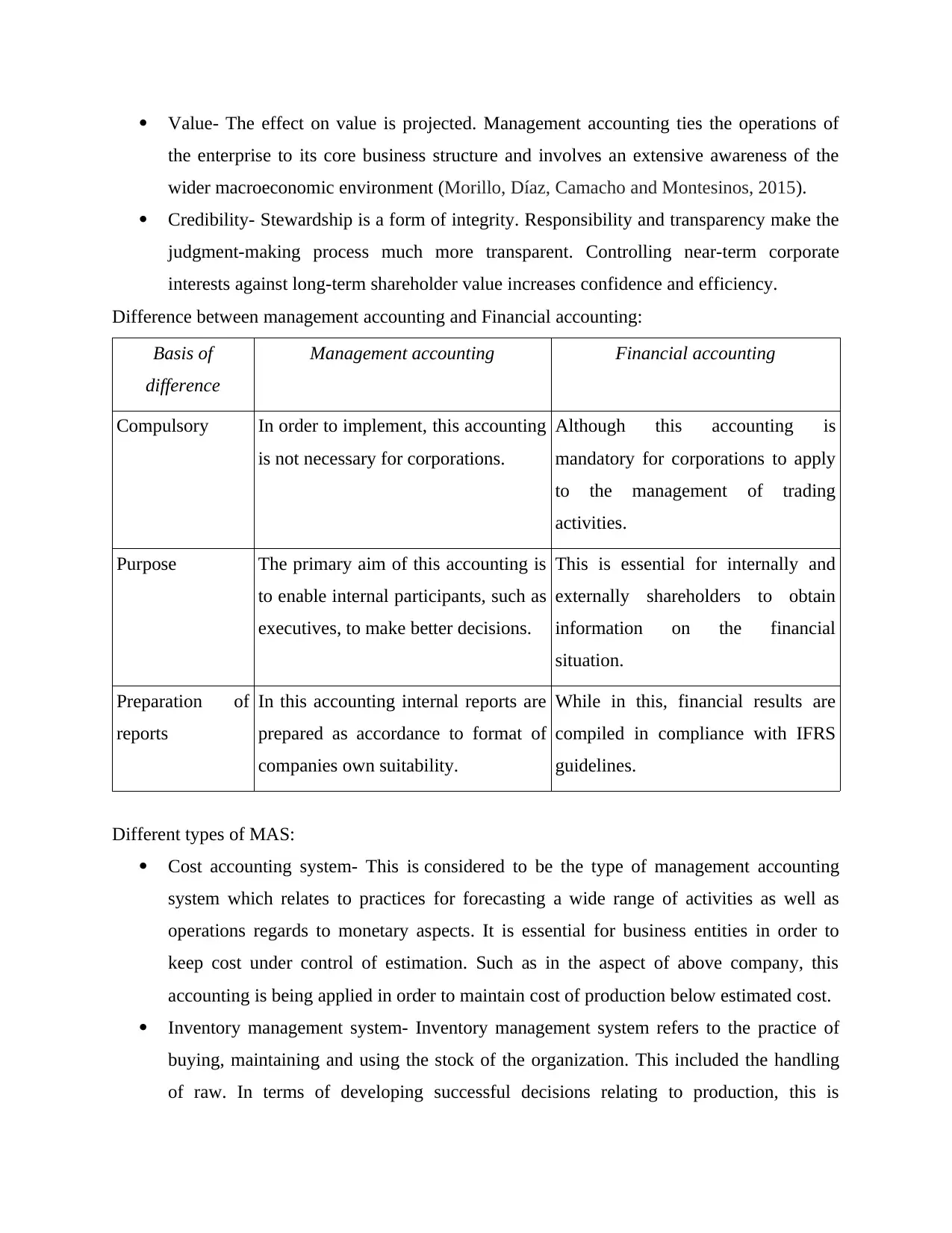
Value- The effect on value is projected. Management accounting ties the operations of
the enterprise to its core business structure and involves an extensive awareness of the
wider macroeconomic environment (Morillo, Díaz, Camacho and Montesinos, 2015).
Credibility- Stewardship is a form of integrity. Responsibility and transparency make the
judgment-making process much more transparent. Controlling near-term corporate
interests against long-term shareholder value increases confidence and efficiency.
Difference between management accounting and Financial accounting:
Basis of
difference
Management accounting Financial accounting
Compulsory In order to implement, this accounting
is not necessary for corporations.
Although this accounting is
mandatory for corporations to apply
to the management of trading
activities.
Purpose The primary aim of this accounting is
to enable internal participants, such as
executives, to make better decisions.
This is essential for internally and
externally shareholders to obtain
information on the financial
situation.
Preparation of
reports
In this accounting internal reports are
prepared as accordance to format of
companies own suitability.
While in this, financial results are
compiled in compliance with IFRS
guidelines.
Different types of MAS:
Cost accounting system- This is considered to be the type of management accounting
system which relates to practices for forecasting a wide range of activities as well as
operations regards to monetary aspects. It is essential for business entities in order to
keep cost under control of estimation. Such as in the aspect of above company, this
accounting is being applied in order to maintain cost of production below estimated cost.
Inventory management system- Inventory management system refers to the practice of
buying, maintaining and using the stock of the organization. This included the handling
of raw. In terms of developing successful decisions relating to production, this is
the enterprise to its core business structure and involves an extensive awareness of the
wider macroeconomic environment (Morillo, Díaz, Camacho and Montesinos, 2015).
Credibility- Stewardship is a form of integrity. Responsibility and transparency make the
judgment-making process much more transparent. Controlling near-term corporate
interests against long-term shareholder value increases confidence and efficiency.
Difference between management accounting and Financial accounting:
Basis of
difference
Management accounting Financial accounting
Compulsory In order to implement, this accounting
is not necessary for corporations.
Although this accounting is
mandatory for corporations to apply
to the management of trading
activities.
Purpose The primary aim of this accounting is
to enable internal participants, such as
executives, to make better decisions.
This is essential for internally and
externally shareholders to obtain
information on the financial
situation.
Preparation of
reports
In this accounting internal reports are
prepared as accordance to format of
companies own suitability.
While in this, financial results are
compiled in compliance with IFRS
guidelines.
Different types of MAS:
Cost accounting system- This is considered to be the type of management accounting
system which relates to practices for forecasting a wide range of activities as well as
operations regards to monetary aspects. It is essential for business entities in order to
keep cost under control of estimation. Such as in the aspect of above company, this
accounting is being applied in order to maintain cost of production below estimated cost.
Inventory management system- Inventory management system refers to the practice of
buying, maintaining and using the stock of the organization. This included the handling
of raw. In terms of developing successful decisions relating to production, this is
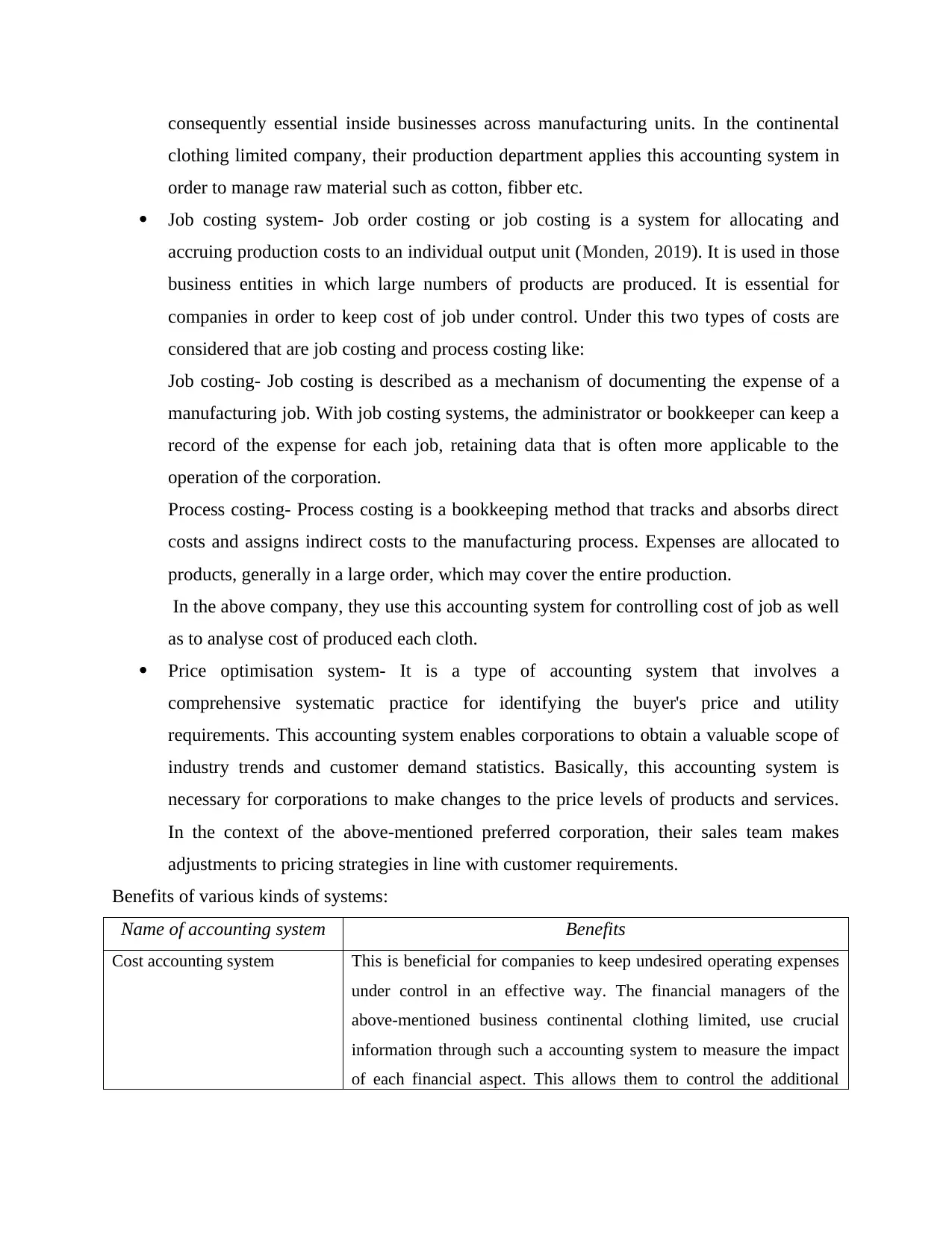
consequently essential inside businesses across manufacturing units. In the continental
clothing limited company, their production department applies this accounting system in
order to manage raw material such as cotton, fibber etc.
Job costing system- Job order costing or job costing is a system for allocating and
accruing production costs to an individual output unit (Monden, 2019). It is used in those
business entities in which large numbers of products are produced. It is essential for
companies in order to keep cost of job under control. Under this two types of costs are
considered that are job costing and process costing like:
Job costing- Job costing is described as a mechanism of documenting the expense of a
manufacturing job. With job costing systems, the administrator or bookkeeper can keep a
record of the expense for each job, retaining data that is often more applicable to the
operation of the corporation.
Process costing- Process costing is a bookkeeping method that tracks and absorbs direct
costs and assigns indirect costs to the manufacturing process. Expenses are allocated to
products, generally in a large order, which may cover the entire production.
In the above company, they use this accounting system for controlling cost of job as well
as to analyse cost of produced each cloth.
Price optimisation system- It is a type of accounting system that involves a
comprehensive systematic practice for identifying the buyer's price and utility
requirements. This accounting system enables corporations to obtain a valuable scope of
industry trends and customer demand statistics. Basically, this accounting system is
necessary for corporations to make changes to the price levels of products and services.
In the context of the above-mentioned preferred corporation, their sales team makes
adjustments to pricing strategies in line with customer requirements.
Benefits of various kinds of systems:
Name of accounting system Benefits
Cost accounting system This is beneficial for companies to keep undesired operating expenses
under control in an effective way. The financial managers of the
above-mentioned business continental clothing limited, use crucial
information through such a accounting system to measure the impact
of each financial aspect. This allows them to control the additional
clothing limited company, their production department applies this accounting system in
order to manage raw material such as cotton, fibber etc.
Job costing system- Job order costing or job costing is a system for allocating and
accruing production costs to an individual output unit (Monden, 2019). It is used in those
business entities in which large numbers of products are produced. It is essential for
companies in order to keep cost of job under control. Under this two types of costs are
considered that are job costing and process costing like:
Job costing- Job costing is described as a mechanism of documenting the expense of a
manufacturing job. With job costing systems, the administrator or bookkeeper can keep a
record of the expense for each job, retaining data that is often more applicable to the
operation of the corporation.
Process costing- Process costing is a bookkeeping method that tracks and absorbs direct
costs and assigns indirect costs to the manufacturing process. Expenses are allocated to
products, generally in a large order, which may cover the entire production.
In the above company, they use this accounting system for controlling cost of job as well
as to analyse cost of produced each cloth.
Price optimisation system- It is a type of accounting system that involves a
comprehensive systematic practice for identifying the buyer's price and utility
requirements. This accounting system enables corporations to obtain a valuable scope of
industry trends and customer demand statistics. Basically, this accounting system is
necessary for corporations to make changes to the price levels of products and services.
In the context of the above-mentioned preferred corporation, their sales team makes
adjustments to pricing strategies in line with customer requirements.
Benefits of various kinds of systems:
Name of accounting system Benefits
Cost accounting system This is beneficial for companies to keep undesired operating expenses
under control in an effective way. The financial managers of the
above-mentioned business continental clothing limited, use crucial
information through such a accounting system to measure the impact
of each financial aspect. This allows them to control the additional
Paraphrase This Document
Need a fresh take? Get an instant paraphrase of this document with our AI Paraphraser
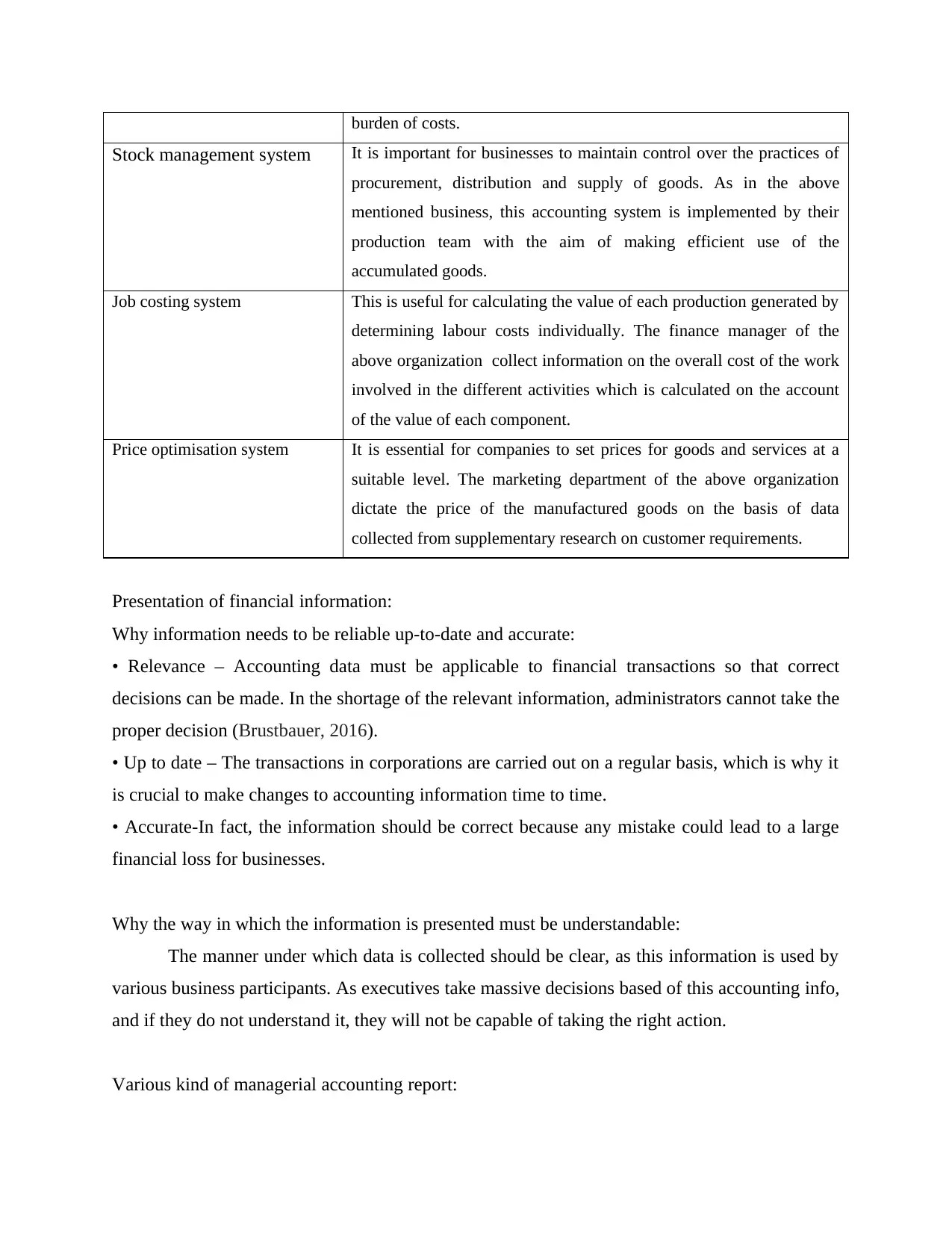
burden of costs.
Stock management system It is important for businesses to maintain control over the practices of
procurement, distribution and supply of goods. As in the above
mentioned business, this accounting system is implemented by their
production team with the aim of making efficient use of the
accumulated goods.
Job costing system This is useful for calculating the value of each production generated by
determining labour costs individually. The finance manager of the
above organization collect information on the overall cost of the work
involved in the different activities which is calculated on the account
of the value of each component.
Price optimisation system It is essential for companies to set prices for goods and services at a
suitable level. The marketing department of the above organization
dictate the price of the manufactured goods on the basis of data
collected from supplementary research on customer requirements.
Presentation of financial information:
Why information needs to be reliable up-to-date and accurate:
• Relevance – Accounting data must be applicable to financial transactions so that correct
decisions can be made. In the shortage of the relevant information, administrators cannot take the
proper decision (Brustbauer, 2016).
• Up to date – The transactions in corporations are carried out on a regular basis, which is why it
is crucial to make changes to accounting information time to time.
• Accurate-In fact, the information should be correct because any mistake could lead to a large
financial loss for businesses.
Why the way in which the information is presented must be understandable:
The manner under which data is collected should be clear, as this information is used by
various business participants. As executives take massive decisions based of this accounting info,
and if they do not understand it, they will not be capable of taking the right action.
Various kind of managerial accounting report:
Stock management system It is important for businesses to maintain control over the practices of
procurement, distribution and supply of goods. As in the above
mentioned business, this accounting system is implemented by their
production team with the aim of making efficient use of the
accumulated goods.
Job costing system This is useful for calculating the value of each production generated by
determining labour costs individually. The finance manager of the
above organization collect information on the overall cost of the work
involved in the different activities which is calculated on the account
of the value of each component.
Price optimisation system It is essential for companies to set prices for goods and services at a
suitable level. The marketing department of the above organization
dictate the price of the manufactured goods on the basis of data
collected from supplementary research on customer requirements.
Presentation of financial information:
Why information needs to be reliable up-to-date and accurate:
• Relevance – Accounting data must be applicable to financial transactions so that correct
decisions can be made. In the shortage of the relevant information, administrators cannot take the
proper decision (Brustbauer, 2016).
• Up to date – The transactions in corporations are carried out on a regular basis, which is why it
is crucial to make changes to accounting information time to time.
• Accurate-In fact, the information should be correct because any mistake could lead to a large
financial loss for businesses.
Why the way in which the information is presented must be understandable:
The manner under which data is collected should be clear, as this information is used by
various business participants. As executives take massive decisions based of this accounting info,
and if they do not understand it, they will not be capable of taking the right action.
Various kind of managerial accounting report:
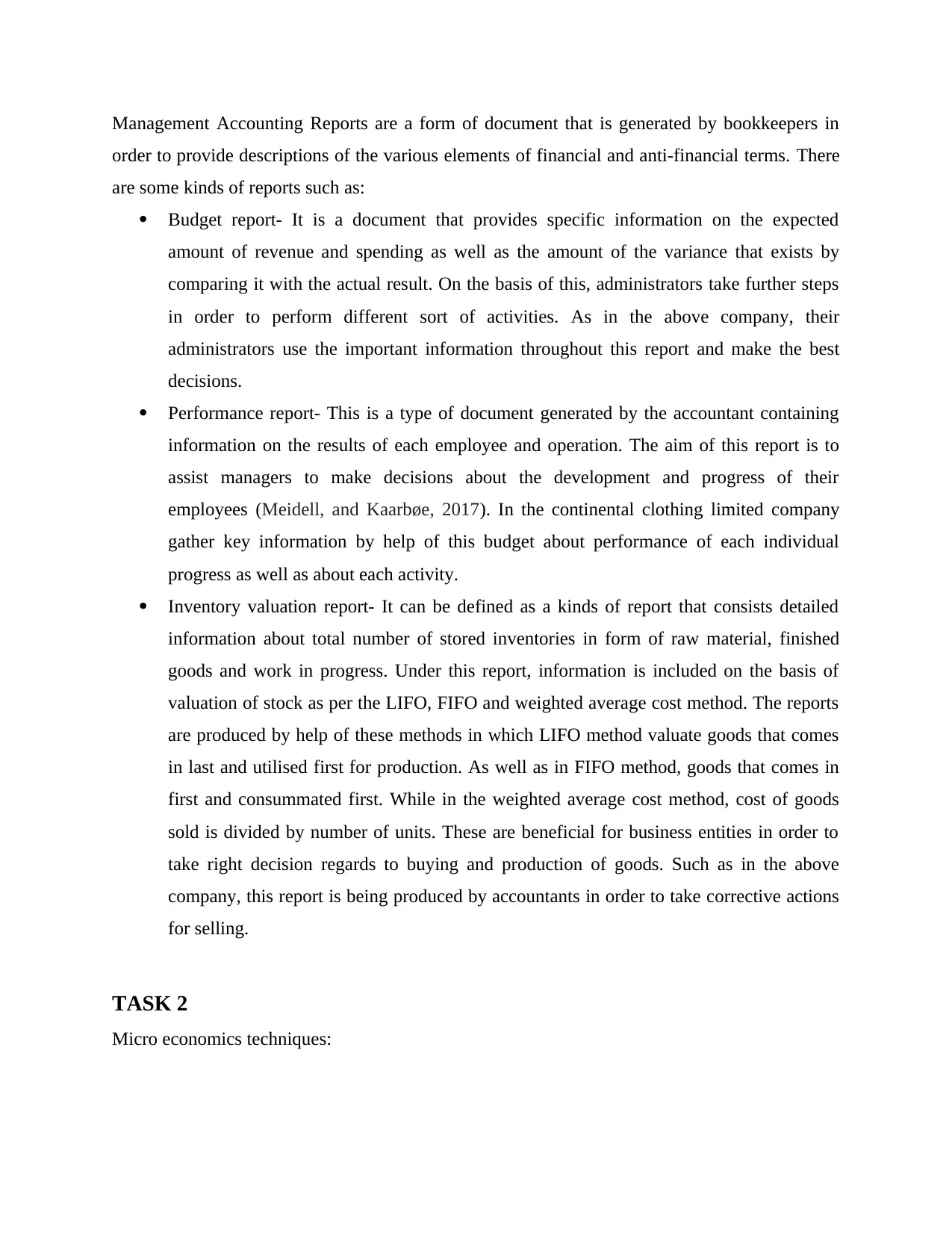
Management Accounting Reports are a form of document that is generated by bookkeepers in
order to provide descriptions of the various elements of financial and anti-financial terms. There
are some kinds of reports such as:
Budget report- It is a document that provides specific information on the expected
amount of revenue and spending as well as the amount of the variance that exists by
comparing it with the actual result. On the basis of this, administrators take further steps
in order to perform different sort of activities. As in the above company, their
administrators use the important information throughout this report and make the best
decisions.
Performance report- This is a type of document generated by the accountant containing
information on the results of each employee and operation. The aim of this report is to
assist managers to make decisions about the development and progress of their
employees (Meidell, and Kaarbøe, 2017). In the continental clothing limited company
gather key information by help of this budget about performance of each individual
progress as well as about each activity.
Inventory valuation report- It can be defined as a kinds of report that consists detailed
information about total number of stored inventories in form of raw material, finished
goods and work in progress. Under this report, information is included on the basis of
valuation of stock as per the LIFO, FIFO and weighted average cost method. The reports
are produced by help of these methods in which LIFO method valuate goods that comes
in last and utilised first for production. As well as in FIFO method, goods that comes in
first and consummated first. While in the weighted average cost method, cost of goods
sold is divided by number of units. These are beneficial for business entities in order to
take right decision regards to buying and production of goods. Such as in the above
company, this report is being produced by accountants in order to take corrective actions
for selling.
TASK 2
Micro economics techniques:
order to provide descriptions of the various elements of financial and anti-financial terms. There
are some kinds of reports such as:
Budget report- It is a document that provides specific information on the expected
amount of revenue and spending as well as the amount of the variance that exists by
comparing it with the actual result. On the basis of this, administrators take further steps
in order to perform different sort of activities. As in the above company, their
administrators use the important information throughout this report and make the best
decisions.
Performance report- This is a type of document generated by the accountant containing
information on the results of each employee and operation. The aim of this report is to
assist managers to make decisions about the development and progress of their
employees (Meidell, and Kaarbøe, 2017). In the continental clothing limited company
gather key information by help of this budget about performance of each individual
progress as well as about each activity.
Inventory valuation report- It can be defined as a kinds of report that consists detailed
information about total number of stored inventories in form of raw material, finished
goods and work in progress. Under this report, information is included on the basis of
valuation of stock as per the LIFO, FIFO and weighted average cost method. The reports
are produced by help of these methods in which LIFO method valuate goods that comes
in last and utilised first for production. As well as in FIFO method, goods that comes in
first and consummated first. While in the weighted average cost method, cost of goods
sold is divided by number of units. These are beneficial for business entities in order to
take right decision regards to buying and production of goods. Such as in the above
company, this report is being produced by accountants in order to take corrective actions
for selling.
TASK 2
Micro economics techniques:
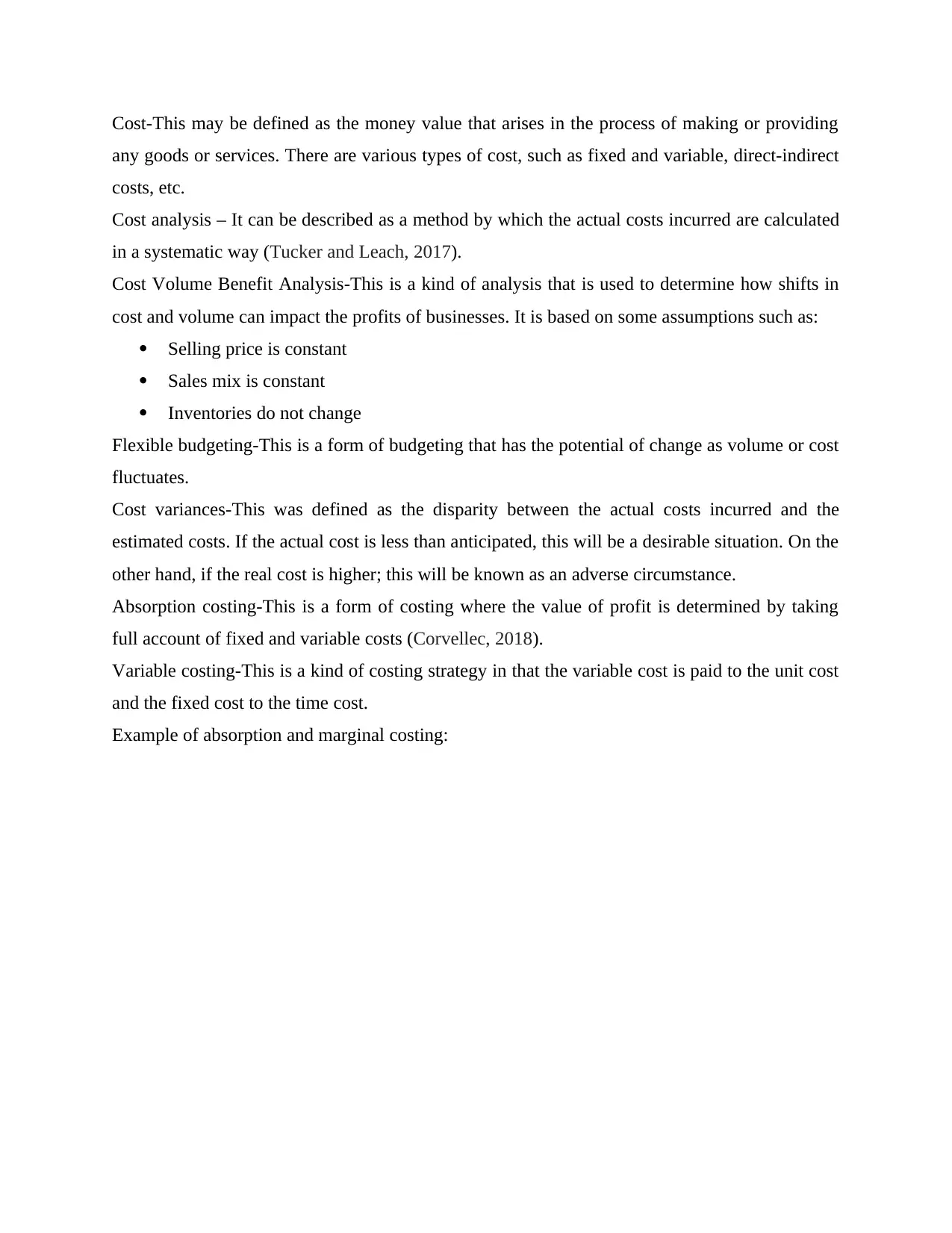
Cost-This may be defined as the money value that arises in the process of making or providing
any goods or services. There are various types of cost, such as fixed and variable, direct-indirect
costs, etc.
Cost analysis – It can be described as a method by which the actual costs incurred are calculated
in a systematic way (Tucker and Leach, 2017).
Cost Volume Benefit Analysis-This is a kind of analysis that is used to determine how shifts in
cost and volume can impact the profits of businesses. It is based on some assumptions such as:
Selling price is constant
Sales mix is constant
Inventories do not change
Flexible budgeting-This is a form of budgeting that has the potential of change as volume or cost
fluctuates.
Cost variances-This was defined as the disparity between the actual costs incurred and the
estimated costs. If the actual cost is less than anticipated, this will be a desirable situation. On the
other hand, if the real cost is higher; this will be known as an adverse circumstance.
Absorption costing-This is a form of costing where the value of profit is determined by taking
full account of fixed and variable costs (Corvellec, 2018).
Variable costing-This is a kind of costing strategy in that the variable cost is paid to the unit cost
and the fixed cost to the time cost.
Example of absorption and marginal costing:
any goods or services. There are various types of cost, such as fixed and variable, direct-indirect
costs, etc.
Cost analysis – It can be described as a method by which the actual costs incurred are calculated
in a systematic way (Tucker and Leach, 2017).
Cost Volume Benefit Analysis-This is a kind of analysis that is used to determine how shifts in
cost and volume can impact the profits of businesses. It is based on some assumptions such as:
Selling price is constant
Sales mix is constant
Inventories do not change
Flexible budgeting-This is a form of budgeting that has the potential of change as volume or cost
fluctuates.
Cost variances-This was defined as the disparity between the actual costs incurred and the
estimated costs. If the actual cost is less than anticipated, this will be a desirable situation. On the
other hand, if the real cost is higher; this will be known as an adverse circumstance.
Absorption costing-This is a form of costing where the value of profit is determined by taking
full account of fixed and variable costs (Corvellec, 2018).
Variable costing-This is a kind of costing strategy in that the variable cost is paid to the unit cost
and the fixed cost to the time cost.
Example of absorption and marginal costing:
Secure Best Marks with AI Grader
Need help grading? Try our AI Grader for instant feedback on your assignments.
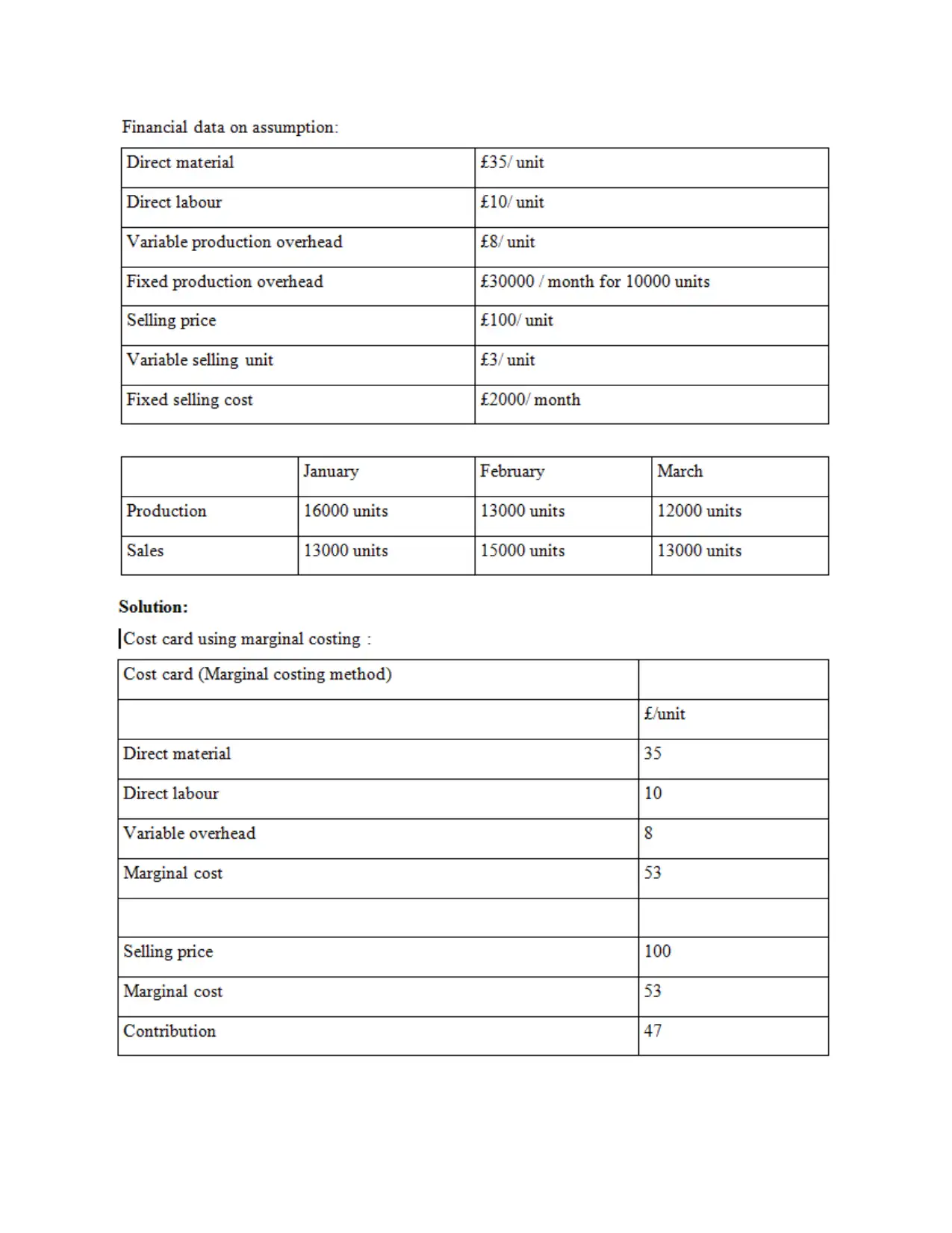
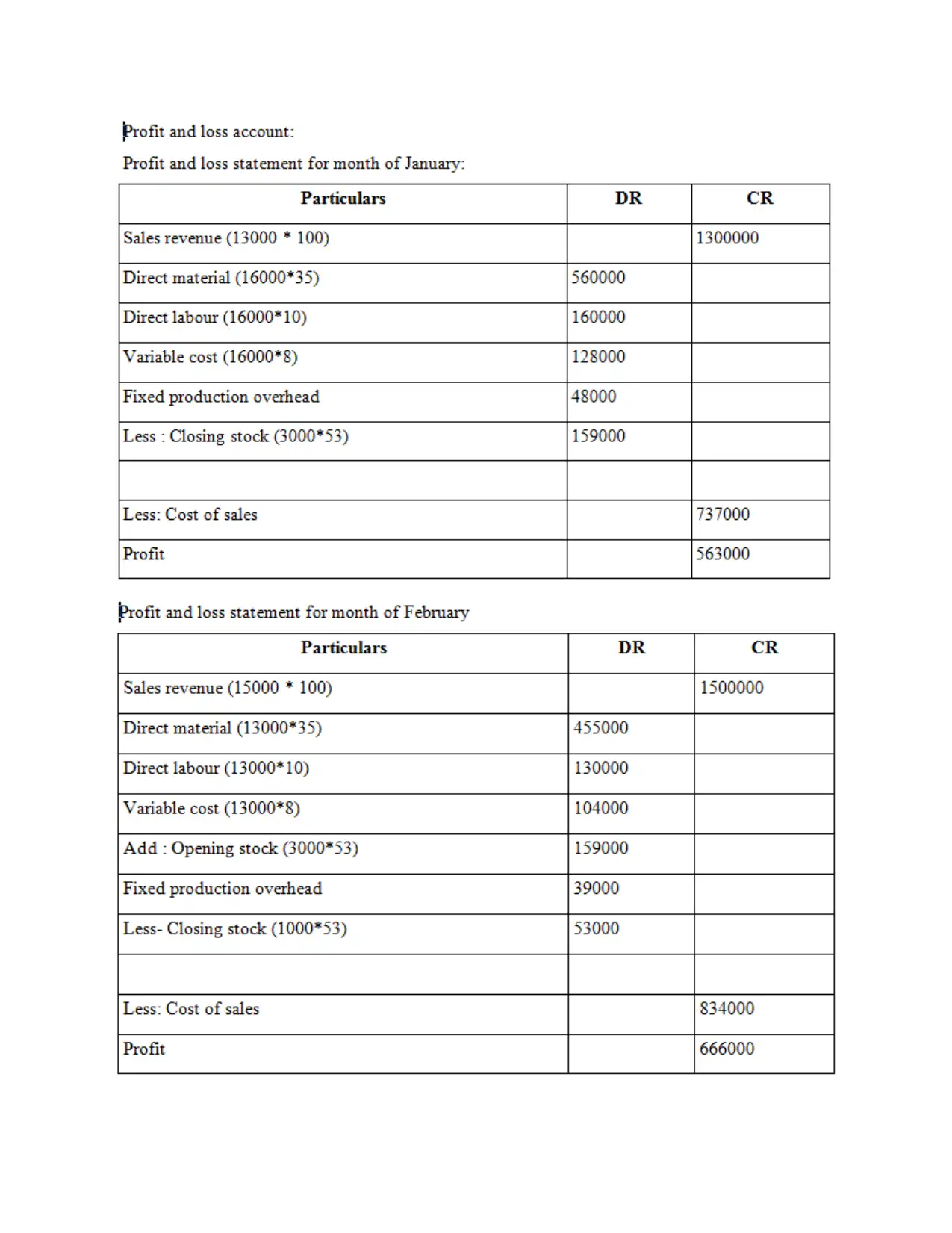
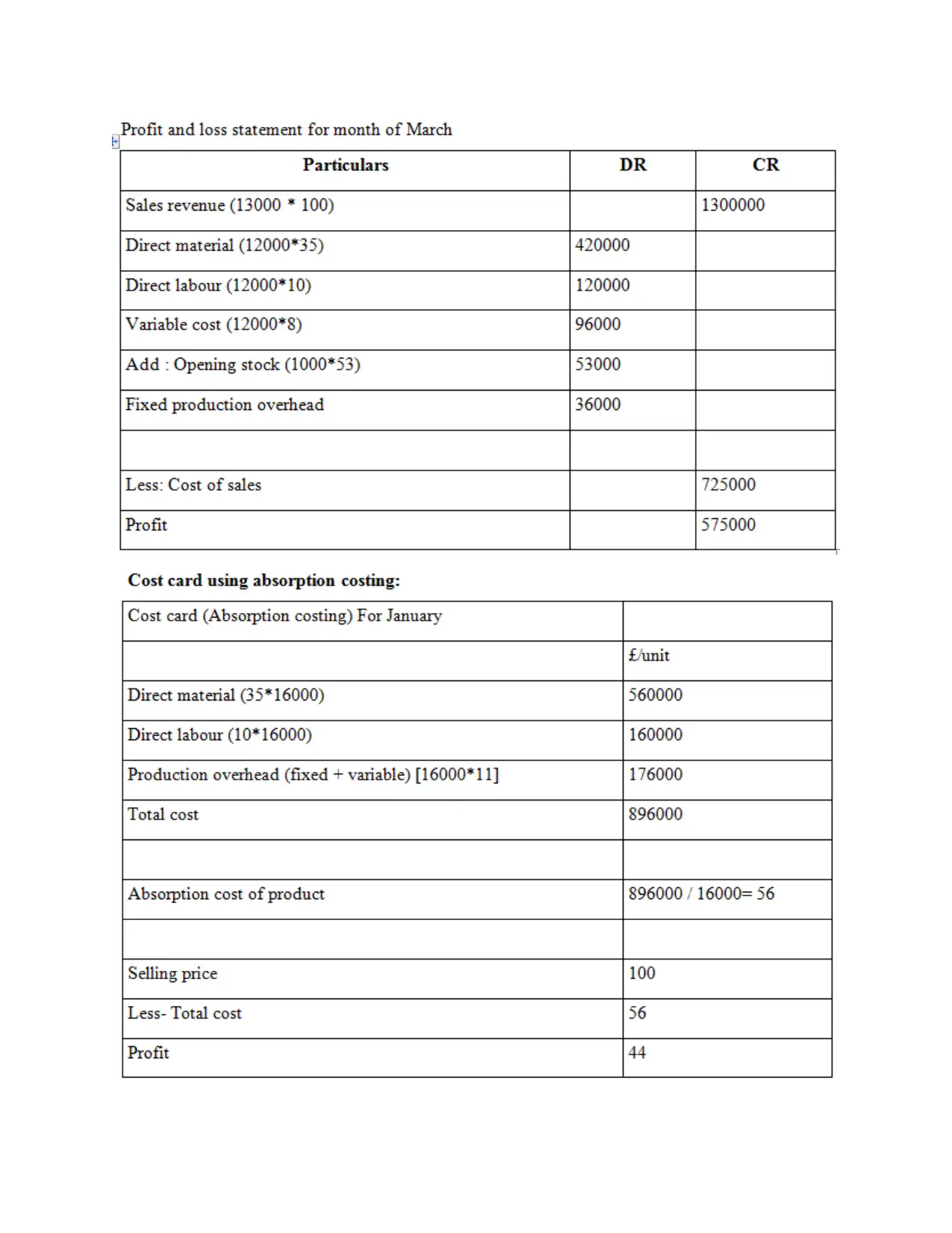
Paraphrase This Document
Need a fresh take? Get an instant paraphrase of this document with our AI Paraphraser
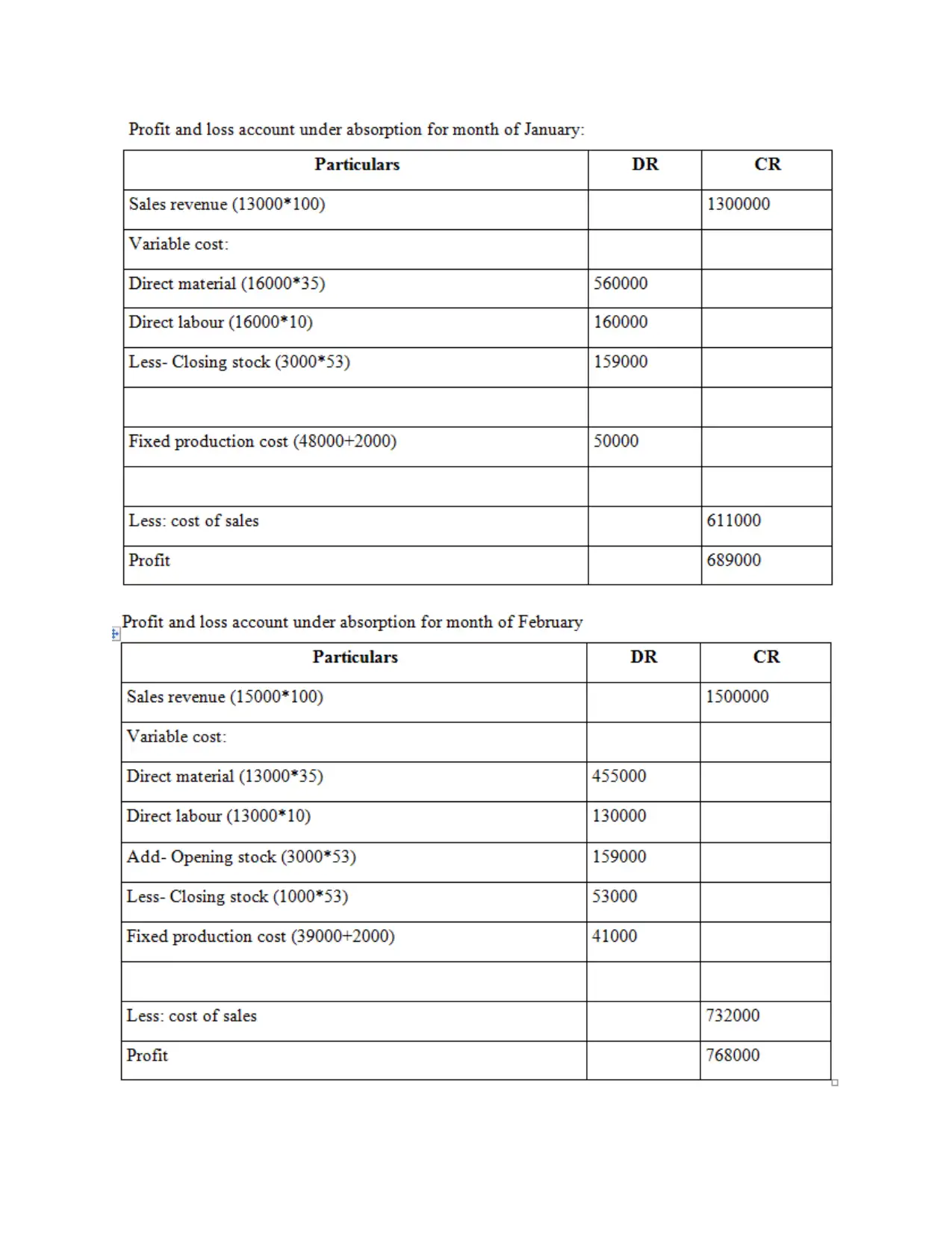
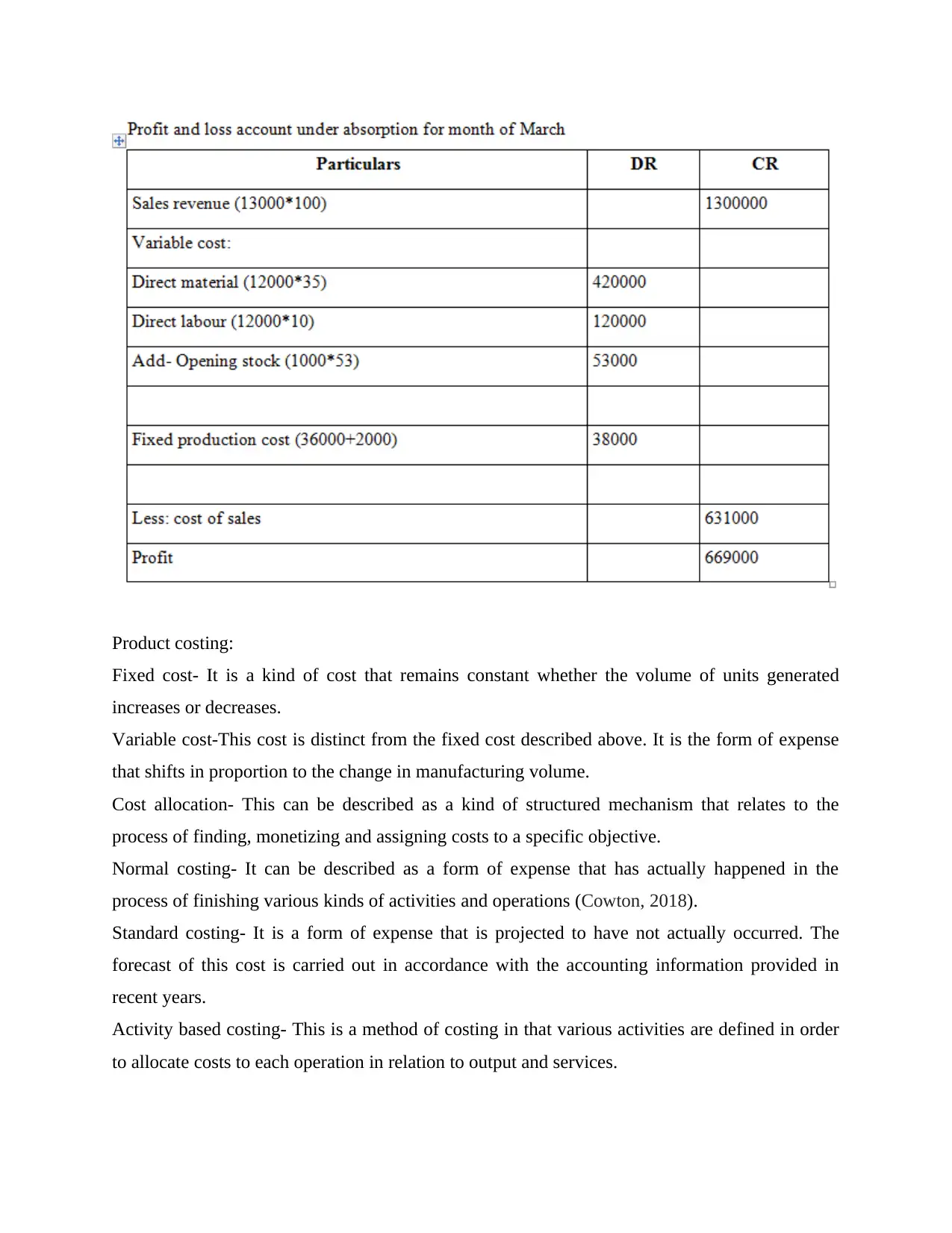
Product costing:
Fixed cost- It is a kind of cost that remains constant whether the volume of units generated
increases or decreases.
Variable cost-This cost is distinct from the fixed cost described above. It is the form of expense
that shifts in proportion to the change in manufacturing volume.
Cost allocation- This can be described as a kind of structured mechanism that relates to the
process of finding, monetizing and assigning costs to a specific objective.
Normal costing- It can be described as a form of expense that has actually happened in the
process of finishing various kinds of activities and operations (Cowton, 2018).
Standard costing- It is a form of expense that is projected to have not actually occurred. The
forecast of this cost is carried out in accordance with the accounting information provided in
recent years.
Activity based costing- This is a method of costing in that various activities are defined in order
to allocate costs to each operation in relation to output and services.
Fixed cost- It is a kind of cost that remains constant whether the volume of units generated
increases or decreases.
Variable cost-This cost is distinct from the fixed cost described above. It is the form of expense
that shifts in proportion to the change in manufacturing volume.
Cost allocation- This can be described as a kind of structured mechanism that relates to the
process of finding, monetizing and assigning costs to a specific objective.
Normal costing- It can be described as a form of expense that has actually happened in the
process of finishing various kinds of activities and operations (Cowton, 2018).
Standard costing- It is a form of expense that is projected to have not actually occurred. The
forecast of this cost is carried out in accordance with the accounting information provided in
recent years.
Activity based costing- This is a method of costing in that various activities are defined in order
to allocate costs to each operation in relation to output and services.
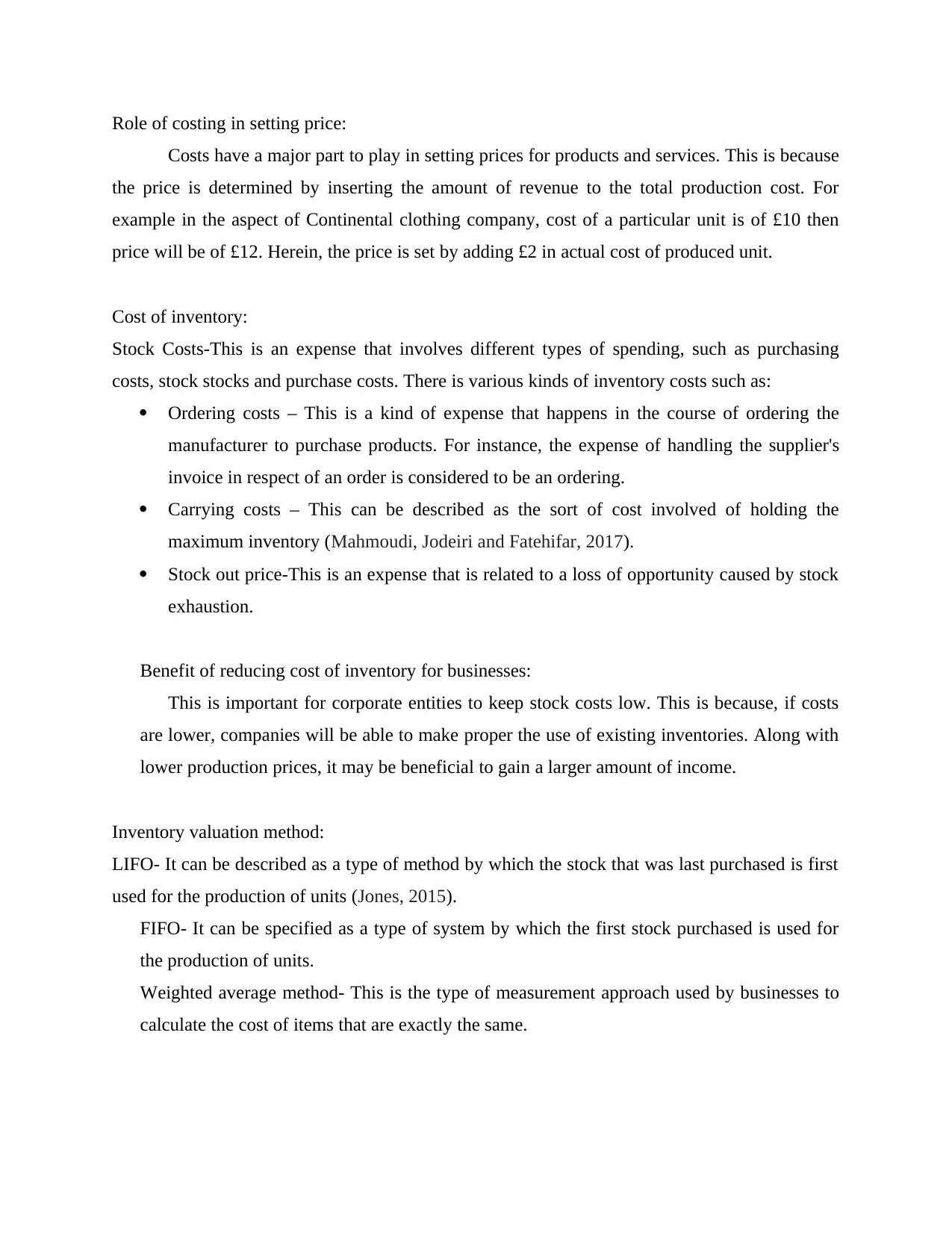
Role of costing in setting price:
Costs have a major part to play in setting prices for products and services. This is because
the price is determined by inserting the amount of revenue to the total production cost. For
example in the aspect of Continental clothing company, cost of a particular unit is of £10 then
price will be of £12. Herein, the price is set by adding £2 in actual cost of produced unit.
Cost of inventory:
Stock Costs-This is an expense that involves different types of spending, such as purchasing
costs, stock stocks and purchase costs. There is various kinds of inventory costs such as:
Ordering costs – This is a kind of expense that happens in the course of ordering the
manufacturer to purchase products. For instance, the expense of handling the supplier's
invoice in respect of an order is considered to be an ordering.
Carrying costs – This can be described as the sort of cost involved of holding the
maximum inventory (Mahmoudi, Jodeiri and Fatehifar, 2017).
Stock out price-This is an expense that is related to a loss of opportunity caused by stock
exhaustion.
Benefit of reducing cost of inventory for businesses:
This is important for corporate entities to keep stock costs low. This is because, if costs
are lower, companies will be able to make proper the use of existing inventories. Along with
lower production prices, it may be beneficial to gain a larger amount of income.
Inventory valuation method:
LIFO- It can be described as a type of method by which the stock that was last purchased is first
used for the production of units (Jones, 2015).
FIFO- It can be specified as a type of system by which the first stock purchased is used for
the production of units.
Weighted average method- This is the type of measurement approach used by businesses to
calculate the cost of items that are exactly the same.
Costs have a major part to play in setting prices for products and services. This is because
the price is determined by inserting the amount of revenue to the total production cost. For
example in the aspect of Continental clothing company, cost of a particular unit is of £10 then
price will be of £12. Herein, the price is set by adding £2 in actual cost of produced unit.
Cost of inventory:
Stock Costs-This is an expense that involves different types of spending, such as purchasing
costs, stock stocks and purchase costs. There is various kinds of inventory costs such as:
Ordering costs – This is a kind of expense that happens in the course of ordering the
manufacturer to purchase products. For instance, the expense of handling the supplier's
invoice in respect of an order is considered to be an ordering.
Carrying costs – This can be described as the sort of cost involved of holding the
maximum inventory (Mahmoudi, Jodeiri and Fatehifar, 2017).
Stock out price-This is an expense that is related to a loss of opportunity caused by stock
exhaustion.
Benefit of reducing cost of inventory for businesses:
This is important for corporate entities to keep stock costs low. This is because, if costs
are lower, companies will be able to make proper the use of existing inventories. Along with
lower production prices, it may be beneficial to gain a larger amount of income.
Inventory valuation method:
LIFO- It can be described as a type of method by which the stock that was last purchased is first
used for the production of units (Jones, 2015).
FIFO- It can be specified as a type of system by which the first stock purchased is used for
the production of units.
Weighted average method- This is the type of measurement approach used by businesses to
calculate the cost of items that are exactly the same.
Secure Best Marks with AI Grader
Need help grading? Try our AI Grader for instant feedback on your assignments.
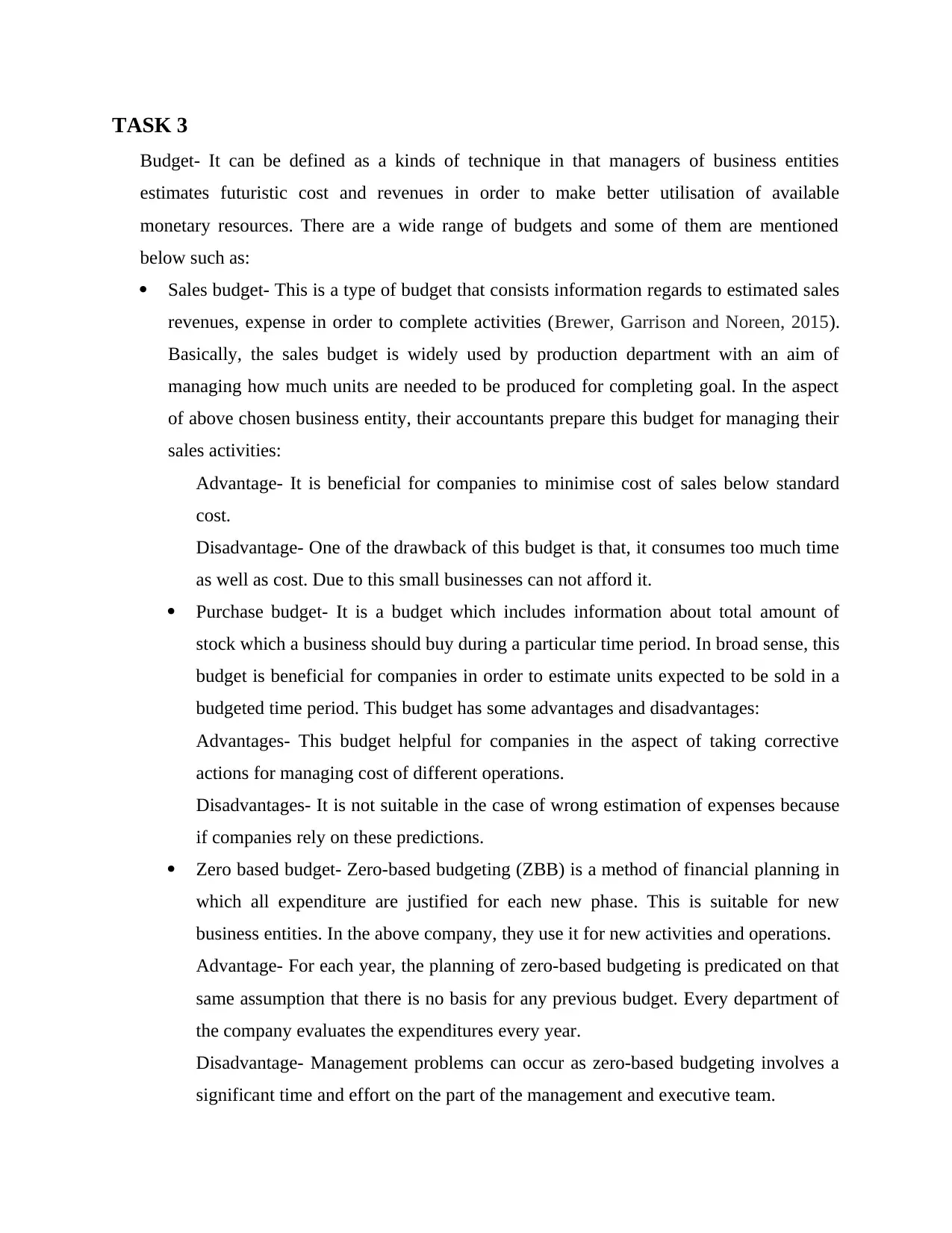
TASK 3
Budget- It can be defined as a kinds of technique in that managers of business entities
estimates futuristic cost and revenues in order to make better utilisation of available
monetary resources. There are a wide range of budgets and some of them are mentioned
below such as:
Sales budget- This is a type of budget that consists information regards to estimated sales
revenues, expense in order to complete activities (Brewer, Garrison and Noreen, 2015).
Basically, the sales budget is widely used by production department with an aim of
managing how much units are needed to be produced for completing goal. In the aspect
of above chosen business entity, their accountants prepare this budget for managing their
sales activities:
Advantage- It is beneficial for companies to minimise cost of sales below standard
cost.
Disadvantage- One of the drawback of this budget is that, it consumes too much time
as well as cost. Due to this small businesses can not afford it.
Purchase budget- It is a budget which includes information about total amount of
stock which a business should buy during a particular time period. In broad sense, this
budget is beneficial for companies in order to estimate units expected to be sold in a
budgeted time period. This budget has some advantages and disadvantages:
Advantages- This budget helpful for companies in the aspect of taking corrective
actions for managing cost of different operations.
Disadvantages- It is not suitable in the case of wrong estimation of expenses because
if companies rely on these predictions.
Zero based budget- Zero-based budgeting (ZBB) is a method of financial planning in
which all expenditure are justified for each new phase. This is suitable for new
business entities. In the above company, they use it for new activities and operations.
Advantage- For each year, the planning of zero-based budgeting is predicated on that
same assumption that there is no basis for any previous budget. Every department of
the company evaluates the expenditures every year.
Disadvantage- Management problems can occur as zero-based budgeting involves a
significant time and effort on the part of the management and executive team.
Budget- It can be defined as a kinds of technique in that managers of business entities
estimates futuristic cost and revenues in order to make better utilisation of available
monetary resources. There are a wide range of budgets and some of them are mentioned
below such as:
Sales budget- This is a type of budget that consists information regards to estimated sales
revenues, expense in order to complete activities (Brewer, Garrison and Noreen, 2015).
Basically, the sales budget is widely used by production department with an aim of
managing how much units are needed to be produced for completing goal. In the aspect
of above chosen business entity, their accountants prepare this budget for managing their
sales activities:
Advantage- It is beneficial for companies to minimise cost of sales below standard
cost.
Disadvantage- One of the drawback of this budget is that, it consumes too much time
as well as cost. Due to this small businesses can not afford it.
Purchase budget- It is a budget which includes information about total amount of
stock which a business should buy during a particular time period. In broad sense, this
budget is beneficial for companies in order to estimate units expected to be sold in a
budgeted time period. This budget has some advantages and disadvantages:
Advantages- This budget helpful for companies in the aspect of taking corrective
actions for managing cost of different operations.
Disadvantages- It is not suitable in the case of wrong estimation of expenses because
if companies rely on these predictions.
Zero based budget- Zero-based budgeting (ZBB) is a method of financial planning in
which all expenditure are justified for each new phase. This is suitable for new
business entities. In the above company, they use it for new activities and operations.
Advantage- For each year, the planning of zero-based budgeting is predicated on that
same assumption that there is no basis for any previous budget. Every department of
the company evaluates the expenditures every year.
Disadvantage- Management problems can occur as zero-based budgeting involves a
significant time and effort on the part of the management and executive team.
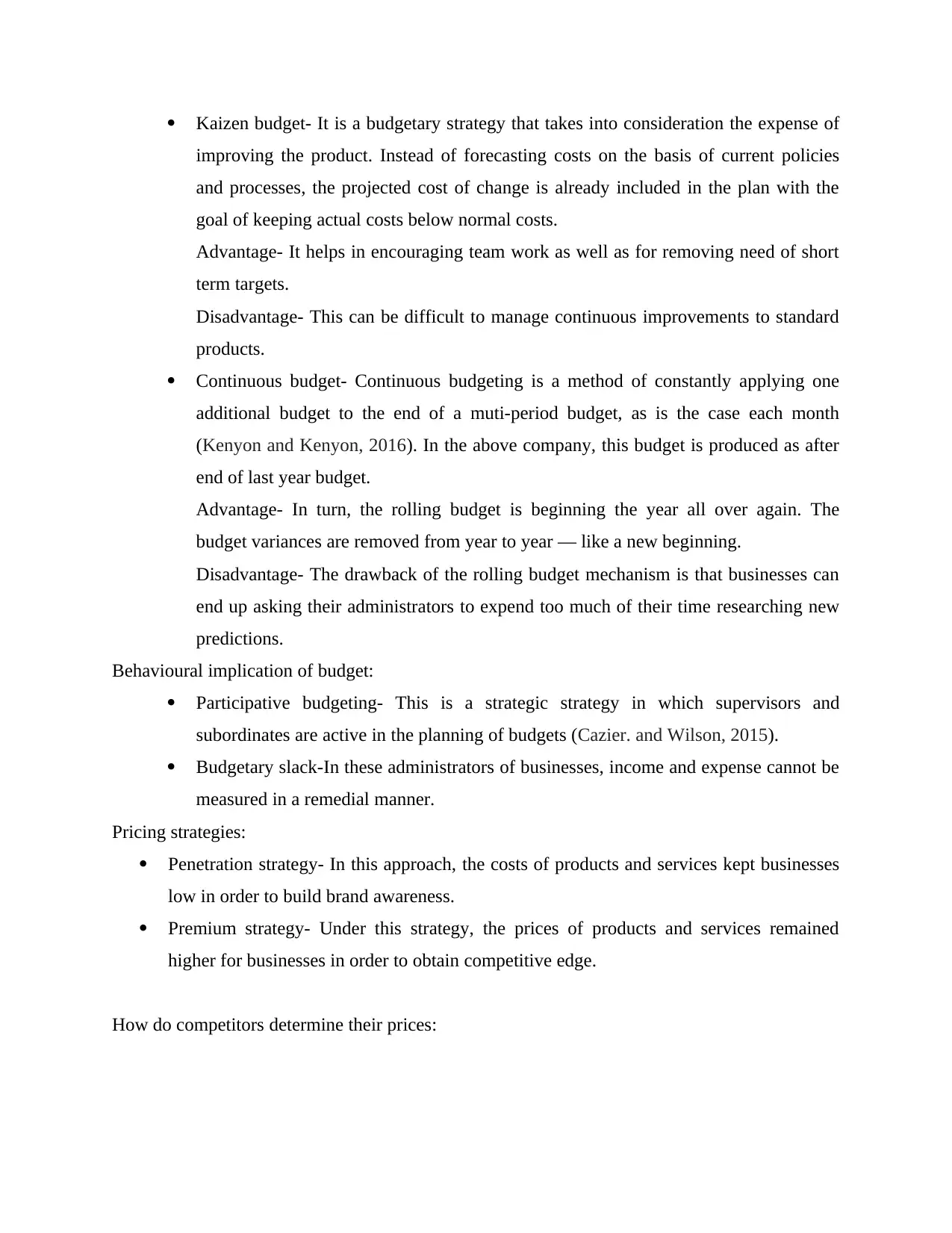
Kaizen budget- It is a budgetary strategy that takes into consideration the expense of
improving the product. Instead of forecasting costs on the basis of current policies
and processes, the projected cost of change is already included in the plan with the
goal of keeping actual costs below normal costs.
Advantage- It helps in encouraging team work as well as for removing need of short
term targets.
Disadvantage- This can be difficult to manage continuous improvements to standard
products.
Continuous budget- Continuous budgeting is a method of constantly applying one
additional budget to the end of a muti-period budget, as is the case each month
(Kenyon and Kenyon, 2016). In the above company, this budget is produced as after
end of last year budget.
Advantage- In turn, the rolling budget is beginning the year all over again. The
budget variances are removed from year to year — like a new beginning.
Disadvantage- The drawback of the rolling budget mechanism is that businesses can
end up asking their administrators to expend too much of their time researching new
predictions.
Behavioural implication of budget:
Participative budgeting- This is a strategic strategy in which supervisors and
subordinates are active in the planning of budgets (Cazier. and Wilson, 2015).
Budgetary slack-In these administrators of businesses, income and expense cannot be
measured in a remedial manner.
Pricing strategies:
Penetration strategy- In this approach, the costs of products and services kept businesses
low in order to build brand awareness.
Premium strategy- Under this strategy, the prices of products and services remained
higher for businesses in order to obtain competitive edge.
How do competitors determine their prices:
improving the product. Instead of forecasting costs on the basis of current policies
and processes, the projected cost of change is already included in the plan with the
goal of keeping actual costs below normal costs.
Advantage- It helps in encouraging team work as well as for removing need of short
term targets.
Disadvantage- This can be difficult to manage continuous improvements to standard
products.
Continuous budget- Continuous budgeting is a method of constantly applying one
additional budget to the end of a muti-period budget, as is the case each month
(Kenyon and Kenyon, 2016). In the above company, this budget is produced as after
end of last year budget.
Advantage- In turn, the rolling budget is beginning the year all over again. The
budget variances are removed from year to year — like a new beginning.
Disadvantage- The drawback of the rolling budget mechanism is that businesses can
end up asking their administrators to expend too much of their time researching new
predictions.
Behavioural implication of budget:
Participative budgeting- This is a strategic strategy in which supervisors and
subordinates are active in the planning of budgets (Cazier. and Wilson, 2015).
Budgetary slack-In these administrators of businesses, income and expense cannot be
measured in a remedial manner.
Pricing strategies:
Penetration strategy- In this approach, the costs of products and services kept businesses
low in order to build brand awareness.
Premium strategy- Under this strategy, the prices of products and services remained
higher for businesses in order to obtain competitive edge.
How do competitors determine their prices:
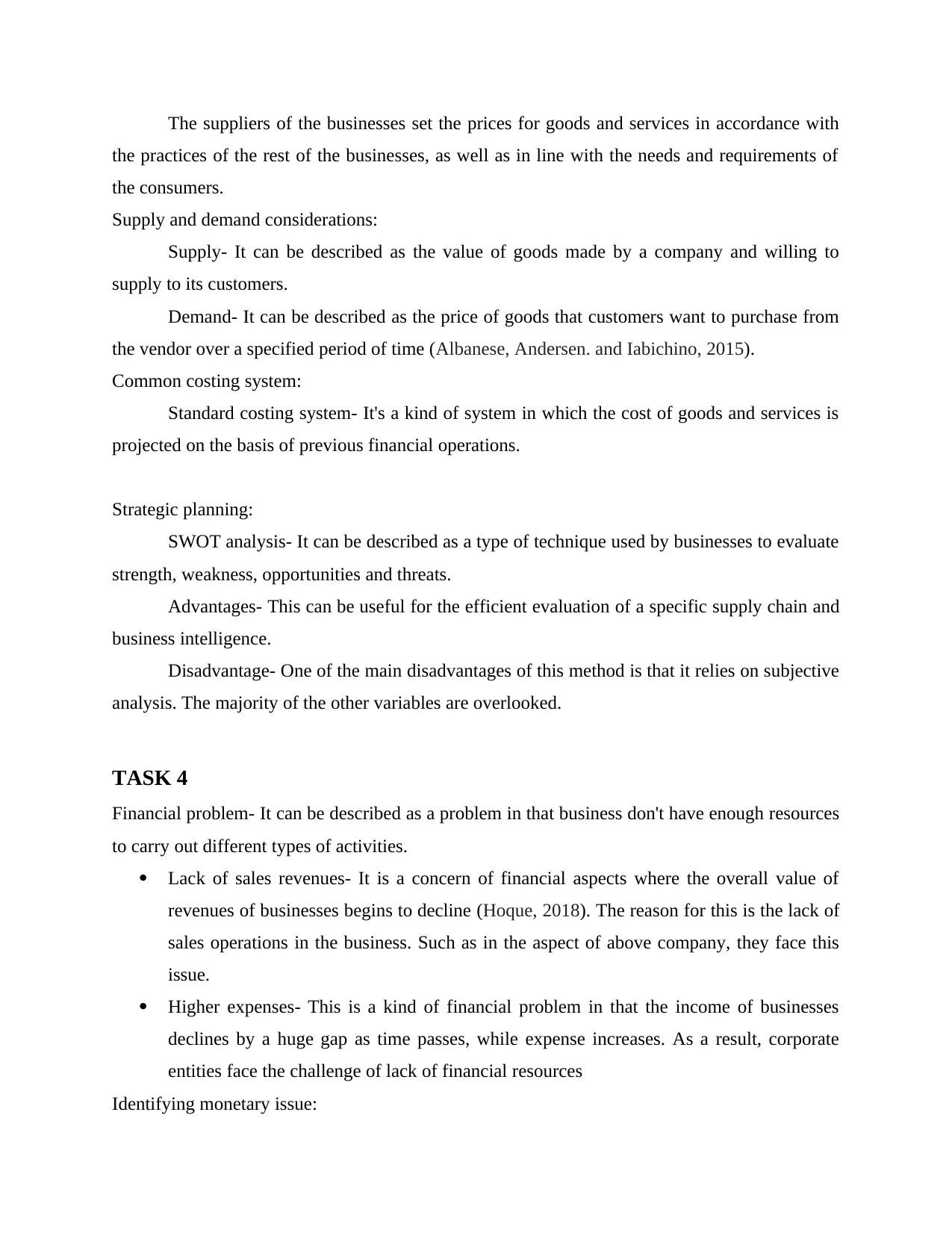
The suppliers of the businesses set the prices for goods and services in accordance with
the practices of the rest of the businesses, as well as in line with the needs and requirements of
the consumers.
Supply and demand considerations:
Supply- It can be described as the value of goods made by a company and willing to
supply to its customers.
Demand- It can be described as the price of goods that customers want to purchase from
the vendor over a specified period of time (Albanese, Andersen. and Iabichino, 2015).
Common costing system:
Standard costing system- It's a kind of system in which the cost of goods and services is
projected on the basis of previous financial operations.
Strategic planning:
SWOT analysis- It can be described as a type of technique used by businesses to evaluate
strength, weakness, opportunities and threats.
Advantages- This can be useful for the efficient evaluation of a specific supply chain and
business intelligence.
Disadvantage- One of the main disadvantages of this method is that it relies on subjective
analysis. The majority of the other variables are overlooked.
TASK 4
Financial problem- It can be described as a problem in that business don't have enough resources
to carry out different types of activities.
Lack of sales revenues- It is a concern of financial aspects where the overall value of
revenues of businesses begins to decline (Hoque, 2018). The reason for this is the lack of
sales operations in the business. Such as in the aspect of above company, they face this
issue.
Higher expenses- This is a kind of financial problem in that the income of businesses
declines by a huge gap as time passes, while expense increases. As a result, corporate
entities face the challenge of lack of financial resources
Identifying monetary issue:
the practices of the rest of the businesses, as well as in line with the needs and requirements of
the consumers.
Supply and demand considerations:
Supply- It can be described as the value of goods made by a company and willing to
supply to its customers.
Demand- It can be described as the price of goods that customers want to purchase from
the vendor over a specified period of time (Albanese, Andersen. and Iabichino, 2015).
Common costing system:
Standard costing system- It's a kind of system in which the cost of goods and services is
projected on the basis of previous financial operations.
Strategic planning:
SWOT analysis- It can be described as a type of technique used by businesses to evaluate
strength, weakness, opportunities and threats.
Advantages- This can be useful for the efficient evaluation of a specific supply chain and
business intelligence.
Disadvantage- One of the main disadvantages of this method is that it relies on subjective
analysis. The majority of the other variables are overlooked.
TASK 4
Financial problem- It can be described as a problem in that business don't have enough resources
to carry out different types of activities.
Lack of sales revenues- It is a concern of financial aspects where the overall value of
revenues of businesses begins to decline (Hoque, 2018). The reason for this is the lack of
sales operations in the business. Such as in the aspect of above company, they face this
issue.
Higher expenses- This is a kind of financial problem in that the income of businesses
declines by a huge gap as time passes, while expense increases. As a result, corporate
entities face the challenge of lack of financial resources
Identifying monetary issue:
Paraphrase This Document
Need a fresh take? Get an instant paraphrase of this document with our AI Paraphraser
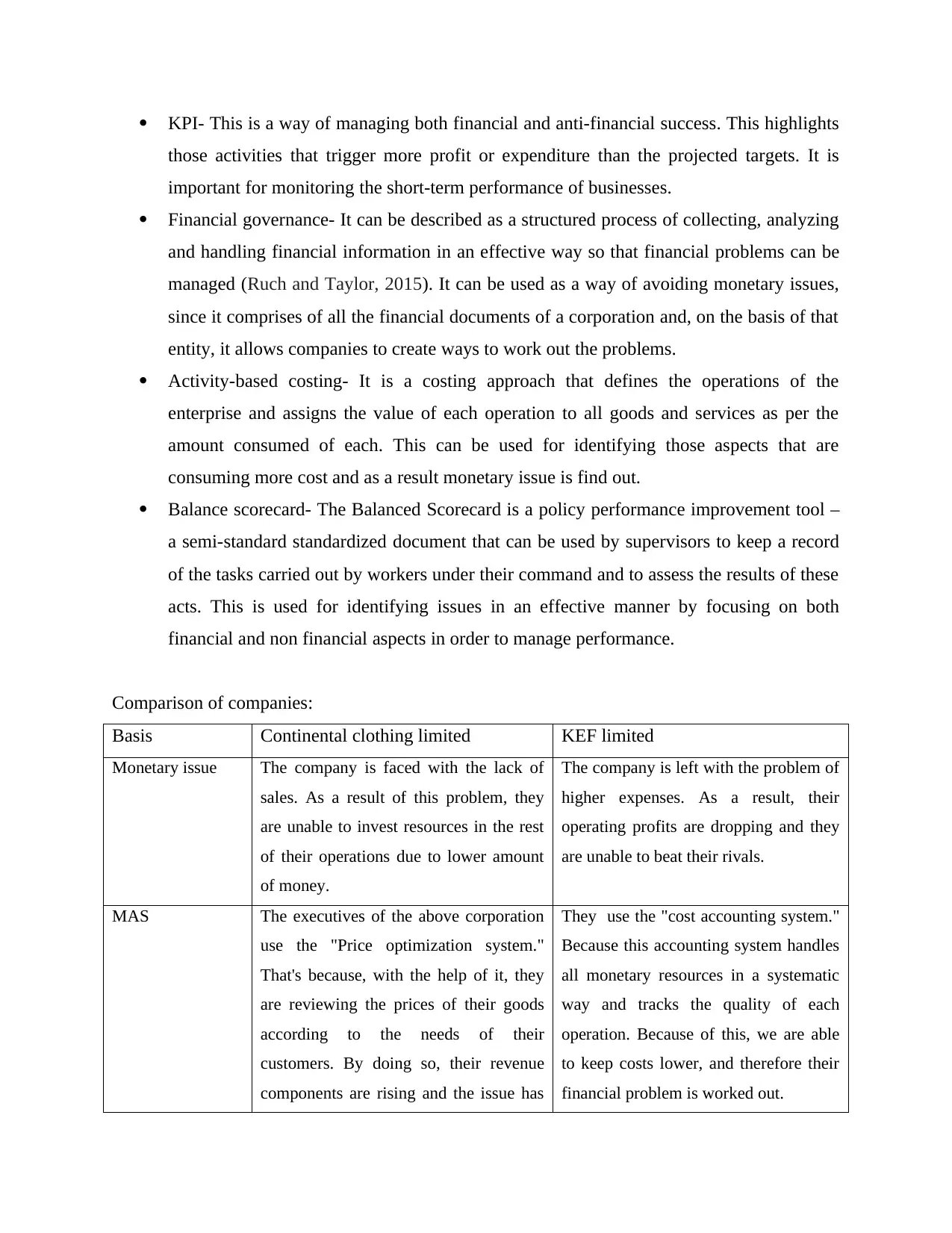
KPI- This is a way of managing both financial and anti-financial success. This highlights
those activities that trigger more profit or expenditure than the projected targets. It is
important for monitoring the short-term performance of businesses.
Financial governance- It can be described as a structured process of collecting, analyzing
and handling financial information in an effective way so that financial problems can be
managed (Ruch and Taylor, 2015). It can be used as a way of avoiding monetary issues,
since it comprises of all the financial documents of a corporation and, on the basis of that
entity, it allows companies to create ways to work out the problems.
Activity-based costing- It is a costing approach that defines the operations of the
enterprise and assigns the value of each operation to all goods and services as per the
amount consumed of each. This can be used for identifying those aspects that are
consuming more cost and as a result monetary issue is find out.
Balance scorecard- The Balanced Scorecard is a policy performance improvement tool –
a semi-standard standardized document that can be used by supervisors to keep a record
of the tasks carried out by workers under their command and to assess the results of these
acts. This is used for identifying issues in an effective manner by focusing on both
financial and non financial aspects in order to manage performance.
Comparison of companies:
Basis Continental clothing limited KEF limited
Monetary issue The company is faced with the lack of
sales. As a result of this problem, they
are unable to invest resources in the rest
of their operations due to lower amount
of money.
The company is left with the problem of
higher expenses. As a result, their
operating profits are dropping and they
are unable to beat their rivals.
MAS The executives of the above corporation
use the "Price optimization system."
That's because, with the help of it, they
are reviewing the prices of their goods
according to the needs of their
customers. By doing so, their revenue
components are rising and the issue has
They use the "cost accounting system."
Because this accounting system handles
all monetary resources in a systematic
way and tracks the quality of each
operation. Because of this, we are able
to keep costs lower, and therefore their
financial problem is worked out.
those activities that trigger more profit or expenditure than the projected targets. It is
important for monitoring the short-term performance of businesses.
Financial governance- It can be described as a structured process of collecting, analyzing
and handling financial information in an effective way so that financial problems can be
managed (Ruch and Taylor, 2015). It can be used as a way of avoiding monetary issues,
since it comprises of all the financial documents of a corporation and, on the basis of that
entity, it allows companies to create ways to work out the problems.
Activity-based costing- It is a costing approach that defines the operations of the
enterprise and assigns the value of each operation to all goods and services as per the
amount consumed of each. This can be used for identifying those aspects that are
consuming more cost and as a result monetary issue is find out.
Balance scorecard- The Balanced Scorecard is a policy performance improvement tool –
a semi-standard standardized document that can be used by supervisors to keep a record
of the tasks carried out by workers under their command and to assess the results of these
acts. This is used for identifying issues in an effective manner by focusing on both
financial and non financial aspects in order to manage performance.
Comparison of companies:
Basis Continental clothing limited KEF limited
Monetary issue The company is faced with the lack of
sales. As a result of this problem, they
are unable to invest resources in the rest
of their operations due to lower amount
of money.
The company is left with the problem of
higher expenses. As a result, their
operating profits are dropping and they
are unable to beat their rivals.
MAS The executives of the above corporation
use the "Price optimization system."
That's because, with the help of it, they
are reviewing the prices of their goods
according to the needs of their
customers. By doing so, their revenue
components are rising and the issue has
They use the "cost accounting system."
Because this accounting system handles
all monetary resources in a systematic
way and tracks the quality of each
operation. Because of this, we are able
to keep costs lower, and therefore their
financial problem is worked out.
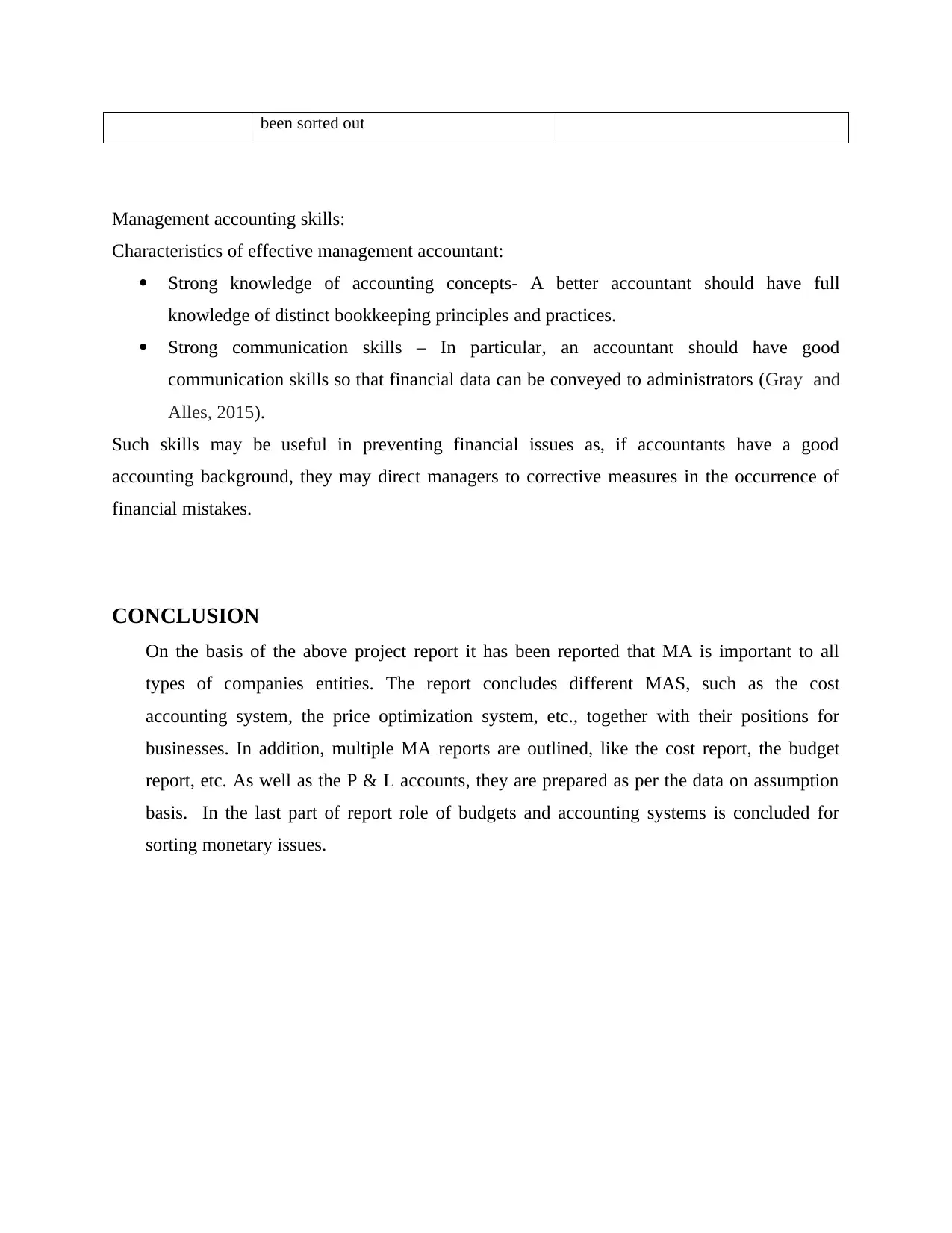
been sorted out
Management accounting skills:
Characteristics of effective management accountant:
Strong knowledge of accounting concepts- A better accountant should have full
knowledge of distinct bookkeeping principles and practices.
Strong communication skills – In particular, an accountant should have good
communication skills so that financial data can be conveyed to administrators (Gray and
Alles, 2015).
Such skills may be useful in preventing financial issues as, if accountants have a good
accounting background, they may direct managers to corrective measures in the occurrence of
financial mistakes.
CONCLUSION
On the basis of the above project report it has been reported that MA is important to all
types of companies entities. The report concludes different MAS, such as the cost
accounting system, the price optimization system, etc., together with their positions for
businesses. In addition, multiple MA reports are outlined, like the cost report, the budget
report, etc. As well as the P & L accounts, they are prepared as per the data on assumption
basis. In the last part of report role of budgets and accounting systems is concluded for
sorting monetary issues.
Management accounting skills:
Characteristics of effective management accountant:
Strong knowledge of accounting concepts- A better accountant should have full
knowledge of distinct bookkeeping principles and practices.
Strong communication skills – In particular, an accountant should have good
communication skills so that financial data can be conveyed to administrators (Gray and
Alles, 2015).
Such skills may be useful in preventing financial issues as, if accountants have a good
accounting background, they may direct managers to corrective measures in the occurrence of
financial mistakes.
CONCLUSION
On the basis of the above project report it has been reported that MA is important to all
types of companies entities. The report concludes different MAS, such as the cost
accounting system, the price optimization system, etc., together with their positions for
businesses. In addition, multiple MA reports are outlined, like the cost report, the budget
report, etc. As well as the P & L accounts, they are prepared as per the data on assumption
basis. In the last part of report role of budgets and accounting systems is concluded for
sorting monetary issues.
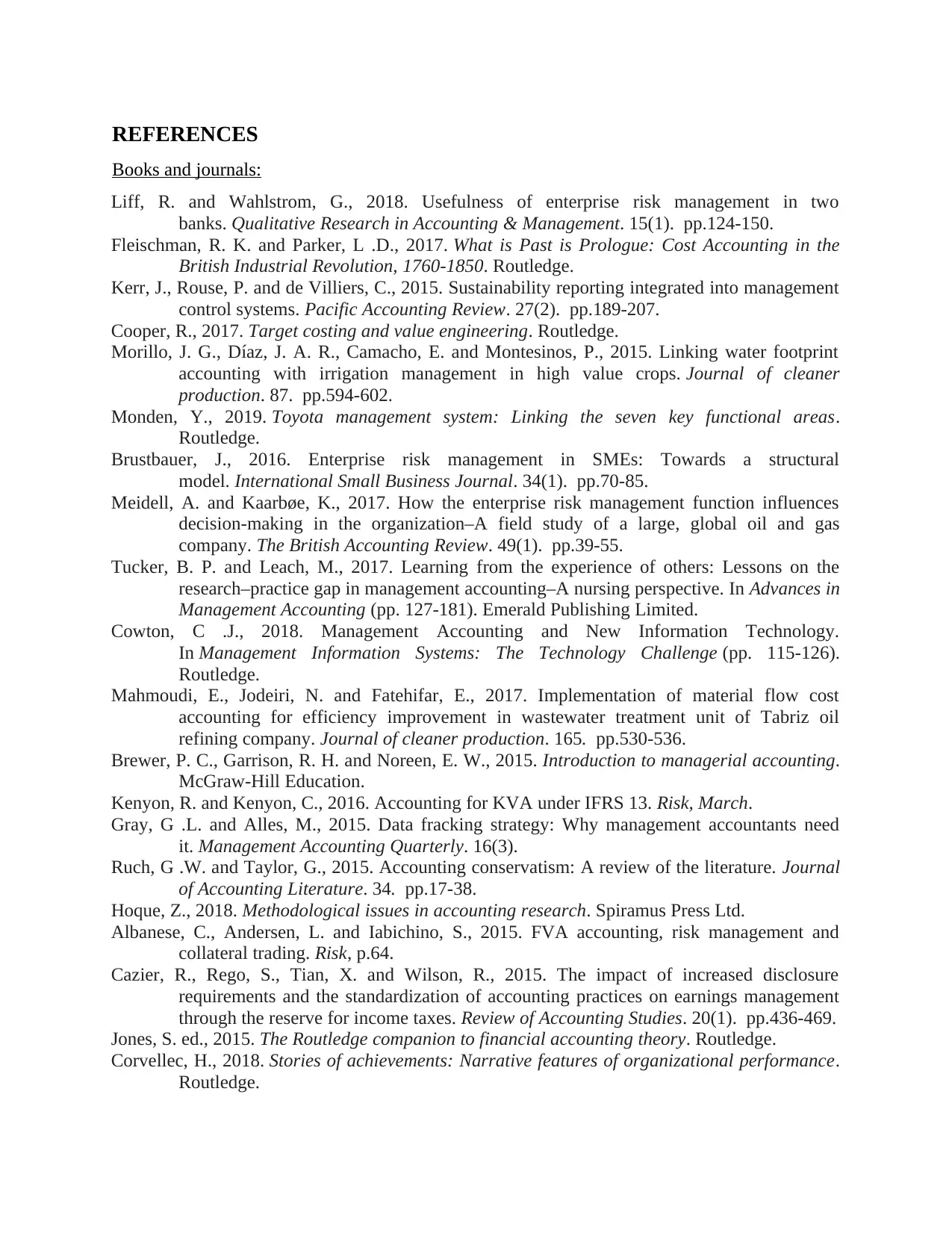
REFERENCES
Books and journals:
Liff, R. and Wahlstrom, G., 2018. Usefulness of enterprise risk management in two
banks. Qualitative Research in Accounting & Management. 15(1). pp.124-150.
Fleischman, R. K. and Parker, L .D., 2017. What is Past is Prologue: Cost Accounting in the
British Industrial Revolution, 1760-1850. Routledge.
Kerr, J., Rouse, P. and de Villiers, C., 2015. Sustainability reporting integrated into management
control systems. Pacific Accounting Review. 27(2). pp.189-207.
Cooper, R., 2017. Target costing and value engineering. Routledge.
Morillo, J. G., Díaz, J. A. R., Camacho, E. and Montesinos, P., 2015. Linking water footprint
accounting with irrigation management in high value crops. Journal of cleaner
production. 87. pp.594-602.
Monden, Y., 2019. Toyota management system: Linking the seven key functional areas.
Routledge.
Brustbauer, J., 2016. Enterprise risk management in SMEs: Towards a structural
model. International Small Business Journal. 34(1). pp.70-85.
Meidell, A. and Kaarbøe, K., 2017. How the enterprise risk management function influences
decision-making in the organization–A field study of a large, global oil and gas
company. The British Accounting Review. 49(1). pp.39-55.
Tucker, B. P. and Leach, M., 2017. Learning from the experience of others: Lessons on the
research–practice gap in management accounting–A nursing perspective. In Advances in
Management Accounting (pp. 127-181). Emerald Publishing Limited.
Cowton, C .J., 2018. Management Accounting and New Information Technology.
In Management Information Systems: The Technology Challenge (pp. 115-126).
Routledge.
Mahmoudi, E., Jodeiri, N. and Fatehifar, E., 2017. Implementation of material flow cost
accounting for efficiency improvement in wastewater treatment unit of Tabriz oil
refining company. Journal of cleaner production. 165. pp.530-536.
Brewer, P. C., Garrison, R. H. and Noreen, E. W., 2015. Introduction to managerial accounting.
McGraw-Hill Education.
Kenyon, R. and Kenyon, C., 2016. Accounting for KVA under IFRS 13. Risk, March.
Gray, G .L. and Alles, M., 2015. Data fracking strategy: Why management accountants need
it. Management Accounting Quarterly. 16(3).
Ruch, G .W. and Taylor, G., 2015. Accounting conservatism: A review of the literature. Journal
of Accounting Literature. 34. pp.17-38.
Hoque, Z., 2018. Methodological issues in accounting research. Spiramus Press Ltd.
Albanese, C., Andersen, L. and Iabichino, S., 2015. FVA accounting, risk management and
collateral trading. Risk, p.64.
Cazier, R., Rego, S., Tian, X. and Wilson, R., 2015. The impact of increased disclosure
requirements and the standardization of accounting practices on earnings management
through the reserve for income taxes. Review of Accounting Studies. 20(1). pp.436-469.
Jones, S. ed., 2015. The Routledge companion to financial accounting theory. Routledge.
Corvellec, H., 2018. Stories of achievements: Narrative features of organizational performance.
Routledge.
Books and journals:
Liff, R. and Wahlstrom, G., 2018. Usefulness of enterprise risk management in two
banks. Qualitative Research in Accounting & Management. 15(1). pp.124-150.
Fleischman, R. K. and Parker, L .D., 2017. What is Past is Prologue: Cost Accounting in the
British Industrial Revolution, 1760-1850. Routledge.
Kerr, J., Rouse, P. and de Villiers, C., 2015. Sustainability reporting integrated into management
control systems. Pacific Accounting Review. 27(2). pp.189-207.
Cooper, R., 2017. Target costing and value engineering. Routledge.
Morillo, J. G., Díaz, J. A. R., Camacho, E. and Montesinos, P., 2015. Linking water footprint
accounting with irrigation management in high value crops. Journal of cleaner
production. 87. pp.594-602.
Monden, Y., 2019. Toyota management system: Linking the seven key functional areas.
Routledge.
Brustbauer, J., 2016. Enterprise risk management in SMEs: Towards a structural
model. International Small Business Journal. 34(1). pp.70-85.
Meidell, A. and Kaarbøe, K., 2017. How the enterprise risk management function influences
decision-making in the organization–A field study of a large, global oil and gas
company. The British Accounting Review. 49(1). pp.39-55.
Tucker, B. P. and Leach, M., 2017. Learning from the experience of others: Lessons on the
research–practice gap in management accounting–A nursing perspective. In Advances in
Management Accounting (pp. 127-181). Emerald Publishing Limited.
Cowton, C .J., 2018. Management Accounting and New Information Technology.
In Management Information Systems: The Technology Challenge (pp. 115-126).
Routledge.
Mahmoudi, E., Jodeiri, N. and Fatehifar, E., 2017. Implementation of material flow cost
accounting for efficiency improvement in wastewater treatment unit of Tabriz oil
refining company. Journal of cleaner production. 165. pp.530-536.
Brewer, P. C., Garrison, R. H. and Noreen, E. W., 2015. Introduction to managerial accounting.
McGraw-Hill Education.
Kenyon, R. and Kenyon, C., 2016. Accounting for KVA under IFRS 13. Risk, March.
Gray, G .L. and Alles, M., 2015. Data fracking strategy: Why management accountants need
it. Management Accounting Quarterly. 16(3).
Ruch, G .W. and Taylor, G., 2015. Accounting conservatism: A review of the literature. Journal
of Accounting Literature. 34. pp.17-38.
Hoque, Z., 2018. Methodological issues in accounting research. Spiramus Press Ltd.
Albanese, C., Andersen, L. and Iabichino, S., 2015. FVA accounting, risk management and
collateral trading. Risk, p.64.
Cazier, R., Rego, S., Tian, X. and Wilson, R., 2015. The impact of increased disclosure
requirements and the standardization of accounting practices on earnings management
through the reserve for income taxes. Review of Accounting Studies. 20(1). pp.436-469.
Jones, S. ed., 2015. The Routledge companion to financial accounting theory. Routledge.
Corvellec, H., 2018. Stories of achievements: Narrative features of organizational performance.
Routledge.
Secure Best Marks with AI Grader
Need help grading? Try our AI Grader for instant feedback on your assignments.

1 out of 23
Related Documents
Your All-in-One AI-Powered Toolkit for Academic Success.
+13062052269
info@desklib.com
Available 24*7 on WhatsApp / Email
![[object Object]](/_next/static/media/star-bottom.7253800d.svg)
Unlock your academic potential
© 2024 | Zucol Services PVT LTD | All rights reserved.





